
All You Need To Know About The Great Himalayan National Park Treks

Credit: himalayancamping.com
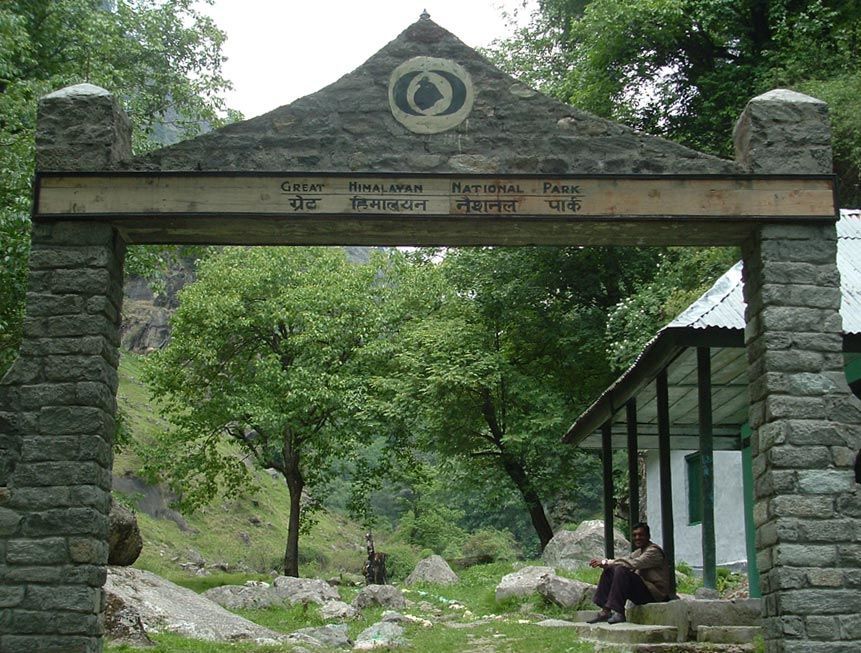
Located in the Kullu district of Himachal Pradesh, the Great Himalayan National Park can be considered as the Holy Grail for the Intrepid Himalayan Trekkers. Gushaini and Jibhi - These 2 campsites are the most common base locations for the Park treks.Here I list for you, most of the common trails to explore the resplendent flora and fauna of the Himalayas.
Gushaini to Rolla:
Rolla(2100 m) is a village inside the entry gate of Great Himalayan National Park(GHNP) and about 8Kms from Gushaini(1500m). A valley which offers a great camping site by the Tirthan river.
The walk to Rolla is mostly flat along the Tirthan River and passes through dense green forests with sparsely populated villages clinging to mountain sides.
A great alternate to camping at Rolla is the campsite at Talinga which is on a flat ground adjacent to the roaring Tirthan River. There is a hanging wooden bridge that goes to the villages of Talinga & Shalinga that completes a pretty picture. The campsite at Talinga is hardly two hours from the bridge at Gushaini.
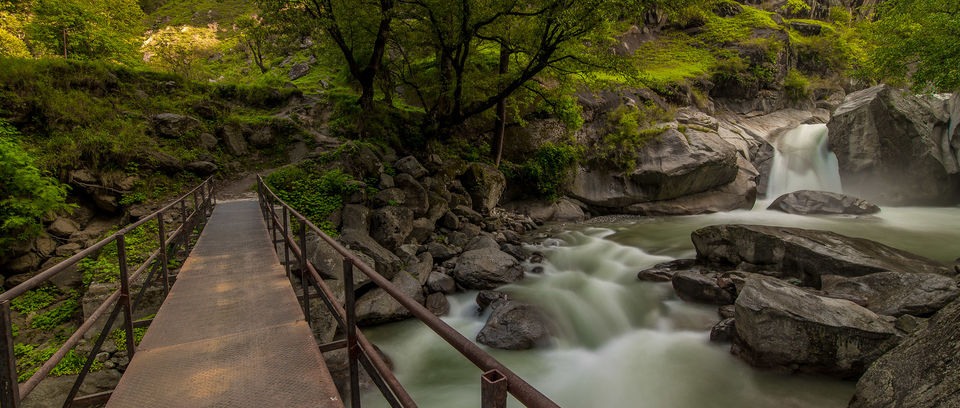
Shilt Hut Trek:
A 7kms hike from Rolla enroute Chhordwari waterfall and bamboo forest will take you to the Shilt Hut(3100 m) which is the next camping site after Rolla and renders a nice view of the Park.
Total distance from Gushaini to Shilt Hut is 30Kms enroute Rolla.
Its a 3 days trek with 1st night at Rolla camp and the 2nd night at Shilt Hut.
Other routes may be explored, but visitors must check with Park officials for entry and route permits for obvious safety reasons.
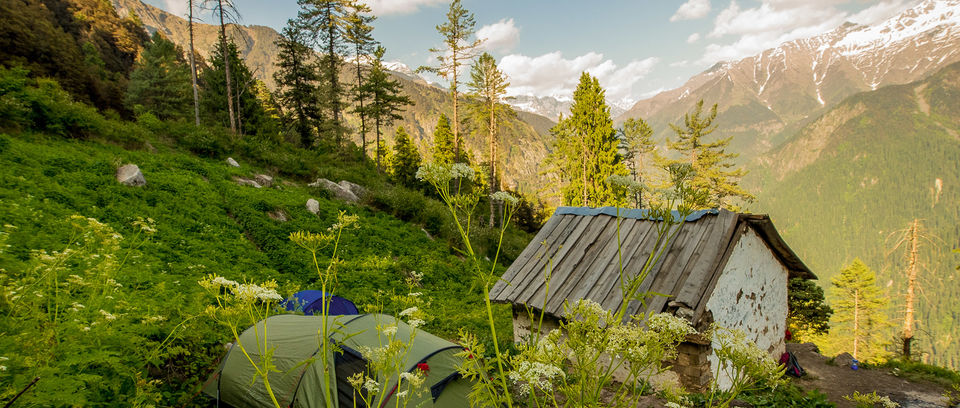
Rangthar Hike:
Rangthar is a flat-topped ridge with a 360 degree view of the Himalayas. The hike starts from Pekhri village ( 1900 Mt) for a trek to Rangthar ( 2700 Mt) . From Pekhri village walk uphill for 4 to 5 Hrs via Lakcha village to reach the top.
Shepherds come with their flocks of sheep to make this a memorable reward for the sharp incline.
Rangthar Top lies in the ecozone of GHNP and is 7 kilometres from Pekhri and one does not require a permit for Rangthar. But make sure you carry sufficient water as Ranghar Top has no water source.
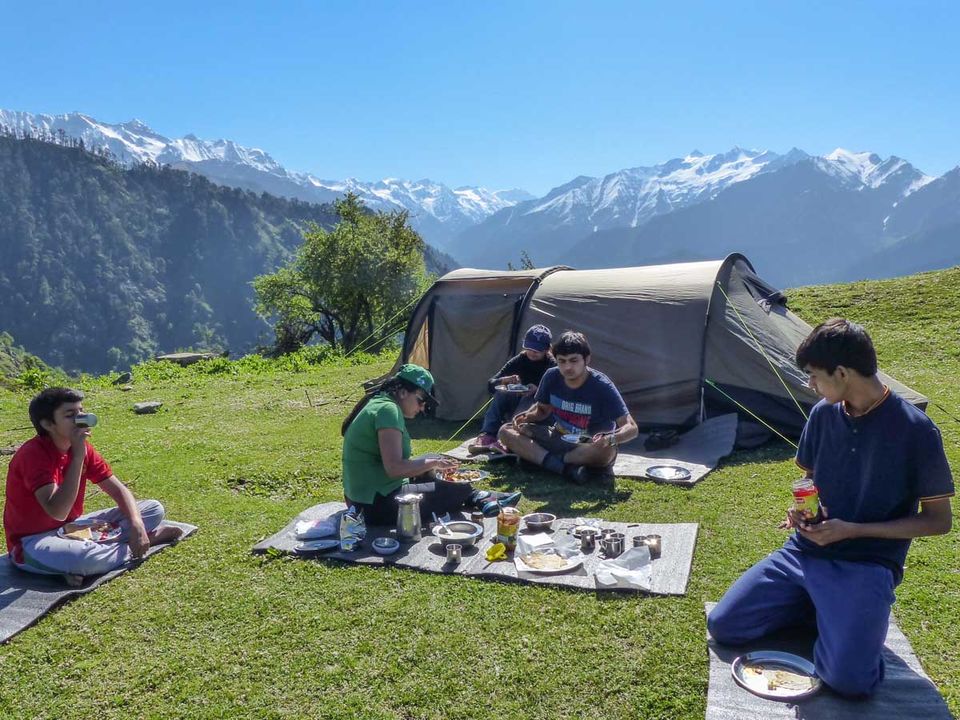
Marahni Trek:
A scenic add-on for your Rangthar Trek can be Marahni Top(3580m) which is another 3-4 hours uphill climb from Rangthar. However, you have to extend your trek to one more day for enjoying a magnificent sunset from the Marahni Top.
First night camp at Rangthar and then proceed to Marahni Top for the second night camping, eventually returning on the 3rd day making it a 3-day trek.
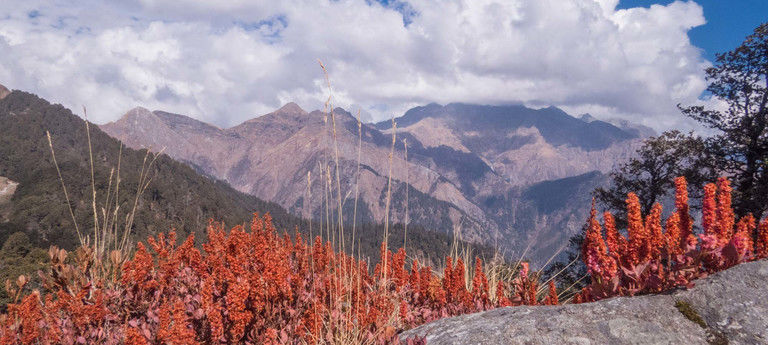
Lambri Top:
A dirt road goes to the pretty village of Sarchi, which is 19 kilometres from Gushaini. Sarchi is located high above in the mountains and is a base for the climb to Lambri Top. The hike passes through pretty forests to the village of Jamala which is a steep one hour climb from Sarchi.
Lambri Top has mesmerising views of the entire Tirthan Valley. It is a lovely place to camp with uninterrupted sights of greenery.
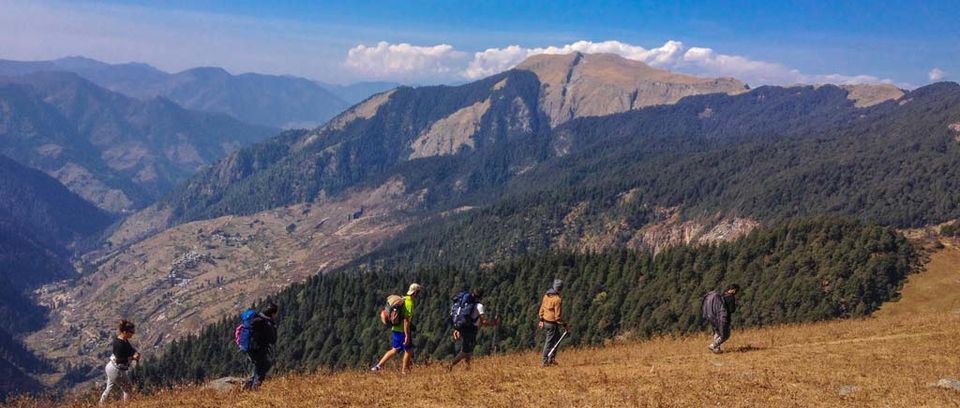
Cheni Kothi Hike:
A short hike which takes half a day or 1 day depending on your stamina. From the village Bihar (1950m) - accessible by road - start climbing for about one hour through the beautiful Deodar forest up to Myagi (2300m), a very small village where you have a nice spot for observing the Park area and even some far off glaciers.
From Myagi, continue to the village Chehani (2130m) where lies one of the most interesting architectural curiosity of the area.
It is a very old and very tall watch tower built with wood and stones and is resistant to earthquakes.
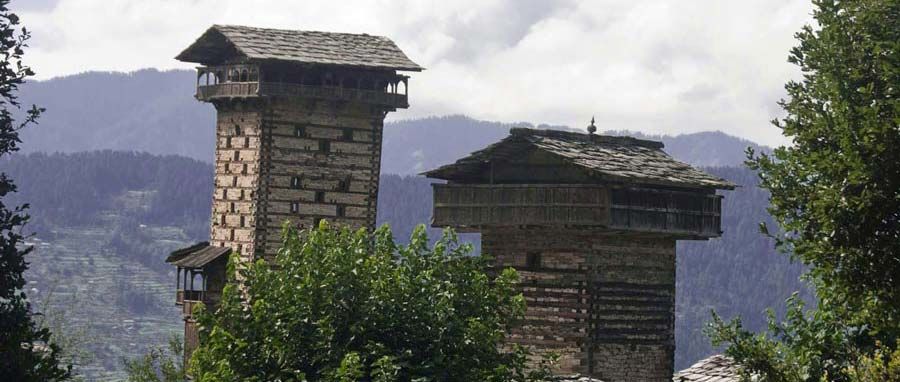
Raktisar Trek:
Get into the heart of GHNP and Sainj River by trekking 6-8 days. Absolutely not for the low-stamina people, technically, this trek is lower in difficulty lever but high on the stamina.
The trek starts from Niharni in Sainj valley and you will reach Shakti Trekker Hut after walking along the Sainj river for 3-4 hours. Night stay at camps in Shakti.
On day 2 trek along the Sainj river and ascent gradually to Parkachi (3000m) thach. Parkachi is famous for bird watching and medicinal herbs.Distance is 10 kms.
Day 3 will commence with the trek to Rakti Sar (4500 m) along the river. Quite a strenuous ascent through rocky portions. Crossing of streams along the route is tricky. Distance is 14 kms.
This is a very strenuous trek. The melting snow causes rapid changes in the course of the Sainj river.
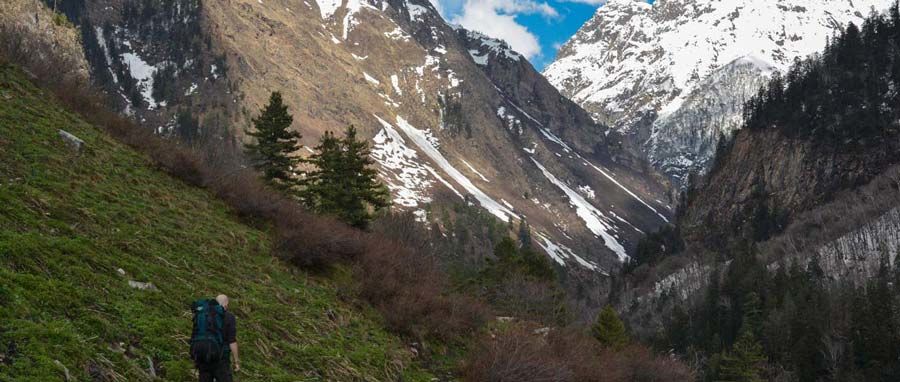
Dhel Meadows Trek:
Start from Niharni in Sainj valley to reach the popular Shakti trekkers camp in 1 day, followed by climbing straight to Humkani and the Bheradnala meadow through dense oak forest on the second day. The slope goes steeply, but the hike is relatively short. It will take about 3 hours walking to reach Bheradnala. You will have time to enjoy the spectacular scenery GHNP is famous for and enjoy the surrounding nature and wildlife.
On the third day, one climbs towards Dhel. You spend an amazing day through very dense and virgin forests. After 3 hours of climb you reach Dhel meadow, a fascinating spot from where the scenery is spectacular.An exceptional place for observing rare and wild species of birds and mammals specially magnificent Western Tragopan.
On the 3rd day, you will be crossing a high attitude pass at about 4090 m height. Say good-bye to Sainj valley, you are now in Tirthan valley. From Dhel it takes 4 hours to reach Ghumtrau, another spectacular meadow.
Start your descend towards Rolla followed by Gushaini on day 4.
You may consider reaching Dhel via the amazingly beautiful village of Shangarh and the village Lapah at the border of the park.
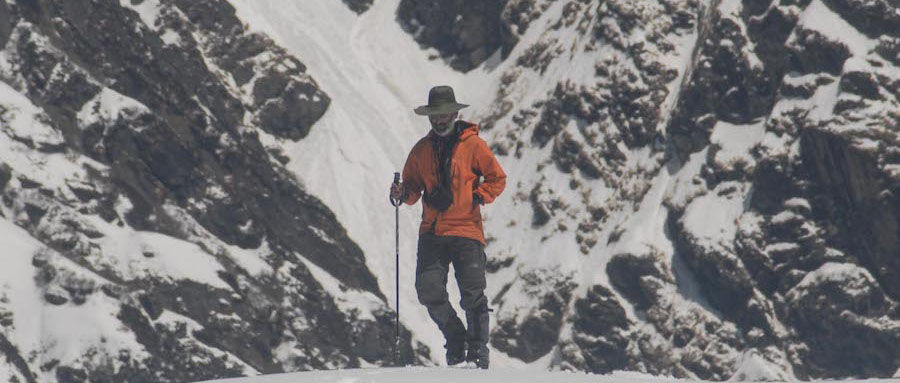
Nada Thach Trek:
This is the trek to the source of Tirthan River. The route is simple-Gushaini-Rolla-Chalocha-Nada Thach-Back.
Reach Rolla on day 1, followed by 3 hours walk through the virgin forest of the Tirthan valley to reach the second campsite at Chalocha on Day 2.
On day 3,follow a small steep trail for 3 hours to reach Nada Thach from where one can see the entire Tirthan valley up to the cirque glacier and the source of the river. The colour of the sunset and the bird-songs put you in a meditative state. Enjoy the meal and spend your evening at the camp fire.
Start descending on the next day after exploring the ornithological-rich Tirthan source.
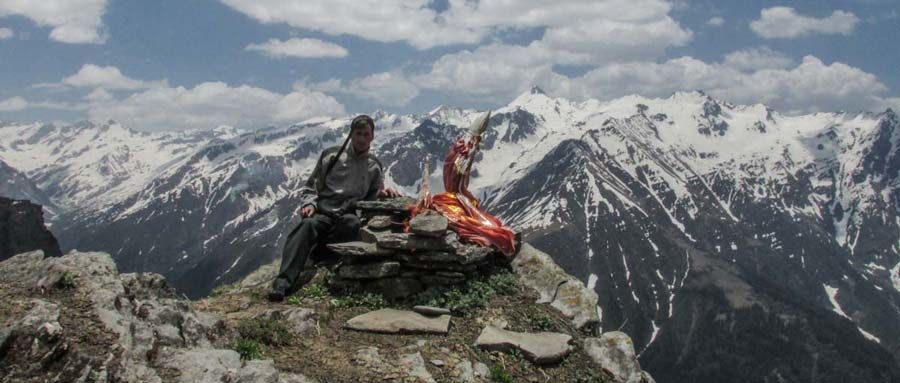
1. Permits are needed to trek inside the GHNP.
2. Its better to take guides/porters with you who knows the trails well.
3. Be prepared with all essentials as most of the Park treks includes multi-faceted landscapes(high meadows/forests/snow region)
4. Both Gushaini and Jibhi has a number of accommodations and home-stays who offers trek guides.
5. Popular trek organizers in this region are Himalayan Ecotourism(its a bit expensive but apt if you are a first-time trekker) and Panki Sood. You can connect him via facebook : https://www.facebook.com/panki.sood
6. Raju Bharti's cottage in Gushaini is the oldest and most popular place to stay in Tirthan Valley and they can organize treks for you as well.
Kullu Packages

More Stories For Kullu
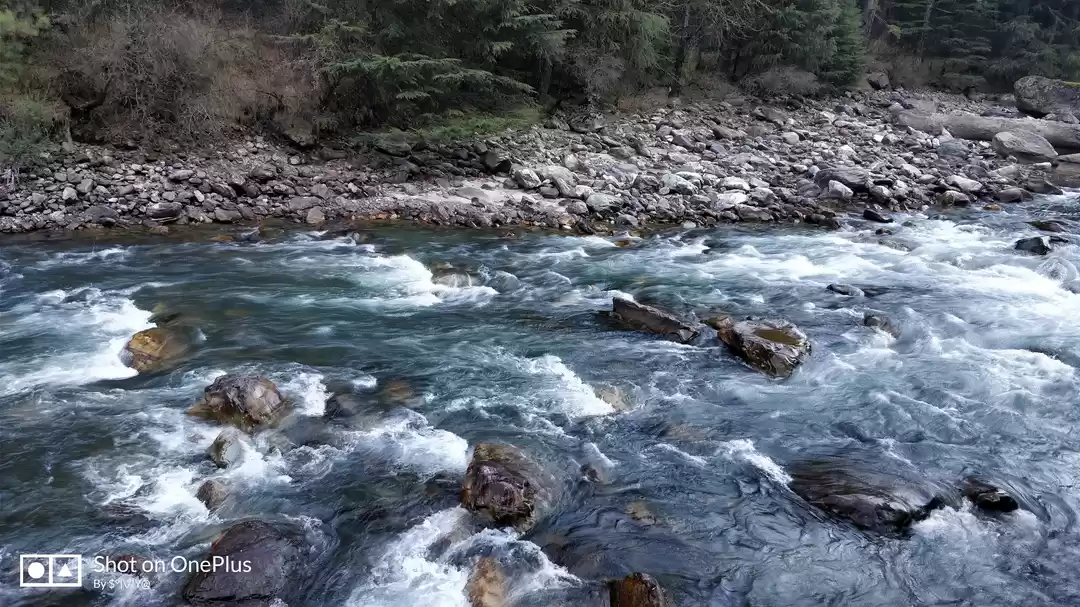
Further Reads
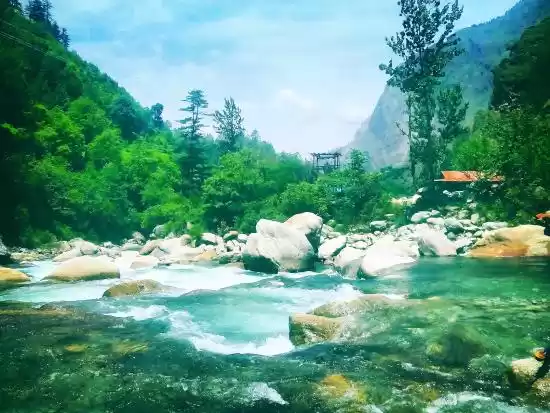

Great Himalayan National Park Trek
Great himalayan national park, soak in the shimmering sunrays filtering through the thick canopy of a forest.
Short Itinerary
Day 1 aut to rola via goshaini | trek: 9 km in 5 - 6 hrs, day 2 rola to shilt; and back to rola | trek: 8 km in 4 km, day 3 rola to aut | trek: 9 km in 4 - 5 hrs, day 2 how difficult is the trek & what are the challenges, what is the best time to do the trek and how is the weather, what are the top highlights of the trek.
- Your designated hotels may not reopen by the time you reach there. While we are making alternate arrangements, do understand that things may not be as “tip-top” as our designated hotels.
- The gurudwara, Hemkund Sahib may not be open. While we are trying to take permission to go to Hemkund Sahib, if it does not happen, then do understand that the pandemic has put restrictions beyond our control.
Upcoming Treks
- 17-07-2021 to 23-07-2021 open
- 17-07-2021 to 23-07-2021 close
Send Request
Your query has been successfully registered. we will contact you within 24 hours., something went wrong.try after sometime..

Visiting the Park
The following are popular GHNP trekking routes have been trekked by Park staff with foreign visitors. Other routes may be explored, but visitors must check with Park officials for entry and route permits for obvious safety reasons.

Click to download larger map of GHNP Trekking Routes
Sainj Valley
A five day trek crossing through the Sainj river valley. Day 1: Neuli (1500 m altitude) to Shakti (2100 m altitude). Night at Shakti Trekkers’ Camp. Moderate ascent. Distance: 22 km Day 2: Shakti to campsite at Lower Meadow Bridge in Homkhani Forest (2800 m). Moderate through dense forest, walnut trees, medicinal herbs, etc. Distance: 6 kms.

Day 3: Rest Day at lower Meadow. Day excursions. Day 4: Return to Shakti. Day 5: Return to Neuli. Total Distance: 56 km (round trip). To Dhel (3737 m)- heavy moderate through dense forest up to beautiful high and wide meadow. Great vistas and opportunities for observing wildlife. Distance: Neuli to Dhel round-trip: 66 kms. top
Sainj-Tirthan Valleys
A eight-day trek crossing two valleys. Moderate to strenuous. Experience the transitions between two magnificent valleys. Day 1: Neuli (1500 m) to Shakti (2100 m). Night at Park accommodation. Moderate ascent. Distance: 22 km Day 2: Shakti to Dhel (3737 m) Heavy-moderate ascent through dense forest, walnut trees, medicinal herbs, etc. Distance: 11 kms.

Day 3 and 4: Rest days at Dehl. Day hikes to Jogni (outdoor prayer sites). Fabulous sunrises and sunsets. Early morning hikes with opportunities to observe wildlife (Red Fox, Himalayan Tahrs) Distance: 4 to 6 kms.

Click to view larger photo of Trekkers at Dhel Thatch
Day 5: Dehl to Guntrao (3500 m): Strenuous. Moving to higher elevations (4120 meters). Difficult trail for more than one hour through very narrow path with sheer drops of 200 meters. Good chance of seeing Himalayan Tahr. A long day on the trail. Must be in very good shape, but worth the effort. Distance: 15 kms.

Day 6: Rest Day at Guntrao: Early morning opportunities for observing Himalayan Tahr and Musk deer. Day 7: Guntrao to Shilt (3100 m). Moderate up and down. Lush bamboo forests, streams and waterfalls. Shilt campsite offers opportunities for evening wildlife. Distance: 16 kms. Day 8: Shilt to Gushaini. Steep descent through dense forests. Exiting GHNP into Ecozone. Distance: 15 kms. Note: A reverse route of the above trek is also popular. Distance from Neuli to Gushaini: About 85 kms.
Gushaini to Shilt Hut
Easy to Moderate three day hike from Ecozone into Park. Day 1: Gushaini (1500 m) to Rolla (2100 m). Entry into Park. Easy day. Distance: 9 kms. Day 2: Rolla to Shilt Hut (3100 m): side trip to Chhordwari waterfall and bamboo forest. Distance: 7 kms. Day 3: Shilt to Gushaini: Return. Total Distance: 30 kms.

Jiwa Nala to Parvarti River Valley
A seven-day, very strenuous, dramatic hike crossing the mountain passes at Kandi Galu (3627m), and Phangchi Galu (4636m). Incredible vistas. Must be in excellent physical condition as very demanding with elevation ascent of 2000 meters and 1500 meters descent in one day (total up-down, 3,500 m in one day!). Day 1: Neuli (1650m) to Bhagi Kashahri (2600m). Morning visit to Manu Temple (2200 m). Evening at village school site. Moderate ascent. Distance: 23 kms. Day 2: Bhagi Kashahri to Subli (3300m). Strenuous ascent in early morning (3600 m). Pass through Kandi Galu notch (3627m). Distance 17 kms.

Crossing the glacier ahead of the ‘Galu’
Day 3: Subli to Dwada (3150m). Relatively easy hike passing through birch forests and meadows. Distance 6 kms. Day 4: Rest Day at Dwada: Beautiful meadow surrounded by steep mountain valleys and flowing Jiwanal River. Peaceful and good place to rest after long hike from Subli.

Crossing the Jiva Nal river 3,700 m
Day 5: Rest Day Dwada: Day hike up to Surtu Glacial Pond in Khandedhar with dramatic mountain backdrops. Opportunities for wildlife observation including Brown Bear, Snow Leopard, etc. Distance: 20 kms. round trip. Day 6: Dwada to Chippi (3550m): Very strenuous day. Crossing Phangchi Galu Pass (4636 m) below Khandedhar into Parvarti Valley. Continuous steep ascent over rock scree, boulders, and very narrow paths into high alpine meadows, then higher lichen environments. Can be cold and windy. Descent from Phangchi Galu can have deep snow pack and should be done with great care as steep drops and potentially very dangerous. Sublime peace at the higher elevations. Stressful on knees coming down! Distance: 23 kms. Day 7: Chippi to Pulga: Easier descent back into forests and meadows, ending at village of Pulga. Distance: 18 kms. Total Distance: 110 kms.
Up To Tirath/Tirthan Valley
A beautiful hike with many habitat transitions. Tirath, the origin of the Tirthan River is a pilgrimage site for the local community. Moderate to strenuous. Day 1: Gushaini (1500m) to Rolla (2100m): Walk through Ecozone of GHNP. Gentle gradient at the beginning of trek. Distance: 10 kms. Day 2: Rolla to Nada (3300m) Thach: Moderate to strenuous climb through oak and conifer forests. A prominent tree god near Chalocha (2450 m) from where the climb starts. Possible sightings of Himalayan Tahr or Black Bear. Nada thatch (meadow) very good for bird watching. Distance: 12 kms. Day 3: Nada Thach to Majhoni (3800m): Gradual to steep descent through forests. Distance: 12 kms. Day 4: Majhoni to Tirath (4000m) and back Majhoni: Moderate gradient leading into the vast meadow of Tirath Offering views of magnificent mountain panoramas. Tirath, the origin of Tirthan river has a glacial lake which is sacred to the villagers of Tirthan valley. Vegetation is stunted showing influence of extreme cold temperatures. Distance: 8 kms.

Click to view larger photo of Approach to Tirath
Day 5: Trek from Majhoni to Nada Thach. Distance: 12 kms. Day 6: Rest day at Nada. Bird watching. Day 7: Nada Thatch to Rolla-descent. Distance: 12 km. Day 8: Rolla to Gushaini. Distance: 10 km. Total Distance: 76 kms.
Raktisar in Sainj Valley
A trek to the source of the Sainj River. Moderate to strenuous. Day 1: Neuli (1500 m) to Shakti (2100 m) village. Night at Park accommodation. Moderate ascent. Distance: 22 Km Day 2: Shakti to Parkachi (3000m) thach. Trek along the Sainj river. Gradual ascent. Distance: 10 kms. Day 3: Parkachi thatch to Rakti Sar (4500 m): Along the river, quite a strenuous ascent through rocky portions. Crossing of streams along the route is tricky. Distance: 14 kms. Day 4: Trek from Rakti Sar to Parkachi thatch. Strenuous descent. Distance: 14 kms.

Day 5: Rest day at Parkachi. Bird watching. Medicinal herbs.
Day 6: Parkachi thatch to Shakti village. Gradual descent. Distance: 10 kms.
Day 7: Shakti village to Neuli. Distance: 22 kms. Total Distance: 92 kms.
Crossing the Pin Parvati Pass (5319 meters altitude)
One of the most spectacular treks in the Park crossing a high pass into Spiti. Moderate to strenuous. Must be in good shape and have a local guide for crossing the Pass. Main attractions: Village house architecture; tree deities; old Forest Rest House at Pulga; panoramic views; alpine and sub-alpine pastures; huge glacial structures at Man-Talai onwards; about 7 to 8 kms. long stretch of snow fields on the Pass; changing vegetation and distinct bird, mammal, butterfly life.

Crevasses on way to the Pin Parvati Pass
Day 1: Shamshi (1100 m) to Barsheni (2150 m): by road Trek from Barsheni to Khirganga (2960 m) Distance: 10 kms. A busy trekking route. The sulfur springs at Khirganga are very famous in the area. A number of Sadhus (holy men, hermits) can be seen camping in the vicinity of the springs. Day 2: Khirganga-Tunda Bhuj (3285 m) to Thakur Kuan: Trek is less disturbed, goes through conifer forests, open meadows and birch forests. The journey may be broken in two days, up to Tunda Bhuj (area with high altitude birch forests) in one day and then from there to Thakur Kuan, the next day. Distance: 19 kms Day 3: Thakur Kuan to Pandupul (3700 m) to Mantalai (4200 m): This part of trek is above tree line in high altitude meadows full of medicinal herbs, alpine grasses, bees and butterflies during summer season. It should be done in two days: up to Pandupul in one day and next day to Mantalai. Distance: 20 kms. Day 4: Mantalai to Pin Parvati Pass (5319 m) to base of the snow field in Pin Valley (4075 m): This is the most strenuous part of the Pin Parvati Pass trek. It involves a steep ascent from Mantalai to the Pass and then a descent into the Pin valley. About six to seven kms trek is on snow fields filled with potentially dangerous crevices. Weather may change any time at the Pass. Distance: 14 kms Day 5: Rest day at the base of Pass in Pin Valley.

Crossing Pin Parvati Pass….awesome and dangerous
Day 6: Base of the snow field in Pin Valley to Tariya or near Mud: Trek through arid zone of the cold desert in Pin Valley. The arduous part of the trek is over, but watch out for crossing of streams on the way. This part of trek can be done in two days with a stopover in between. Distance: 11 kms. Day 7: Tariya/Mud to Maling road head onwards by road to Kaza (3600 m): Mud is the first village to come by. The trekker may hire a pony or one of the famous Chamurti bred Tibetan horses to ride up to the roadhead. Distance: 15 kms. Total Distance: 90 kms. Note: A trained guide is required to cross the pass.
What’s new
- Wild Treasures Book Release
- Vishv Dharohar Utsav 2022: Celebrating GHNP
- My Retirement Celebration Trek
- Sanjeeva and Payson’s GHNP Trek September 2018: Payson’s Impressions
- Book on the Great Himalayan National Park released at the Goa Arts and Literature Centre
Twitter updates

Wandering Boots
Great Himalayan National Park Trek
- Trip Type Easy , Wildlife Spotting Trek
- Activities No Activities
- Group Size 14 Max
- Location Himachal Pradesh
- Trip Outline
- Trip Includes
- Trip Excludes
The Great Himalayan National Park (GHNP) is one of the most recent additions to a huge network of wildlife reserves found in Himalayan region in India.
On this trek experience walking through dense forests, over lush green hills, exploring the exotic flora and fauna of the region. You have great chances of spotting some rare birds and mammals including the Blue sheep, the Himalayan Tahr, or even the rare Brown Bear!
GHNP was awarded UNESCO World Heritage Site status in 2014, in recognition of its outstanding significance for biodiversity conservation.
About the Area:
The Great Himalayan National Park is located in Banjaar Sub-Division of Kullu District of Himachal Pradesh, India. Kullu is a prime tourist and adventure destination. It’s unparalleled beauty along with easy accessibility has attracted many adventurists. No wonder some call it the Chamonix of India. The language the people speak here is called Kulvi. Apple is the major cash crop and the whole valley turns red in August!
What to expect from this trek :
Lots of wildlife in the form of birds and mountain goats! Lovely snow clad mountain views of the Parvati valley Offbeat trail, less footfall Wholesome experience with enough breaks near water bodies!
Expected Weather:
- Chances of rain/hail – Low
- Snow on trail- None
- Temperatures: Afternoon – 20 degrees, Nights – Around zero degrees at higher camps
Day 1 - Arrive in Jibhi. Check into the homestay we have booked for you. Trek Briefing in the evening.
Day 2 - Drive to Gushani (1500m) Drive time 1 hour Trek from Gushani to Rolla ( 2100 m) Trek Distance - 9 kms Beautiful walk through forest with mild altitude gain.
Day 3 - Trek from Rolla to Shilt hut (3100 m) Trek Distance - 7 kms Moderate altitude gain with steep climbs in part. Overall a moderately challenging day
Day 4 - Trek from Shilt hut to Rakhundi (3622 m) Trek Distance - 7 kms Moderate altitude gain. Overall a moderately challenging day. Very picturesque day
Day 5 - Trek from Rakhundi to Rolla (2100m) Trek Distance - 13 kms All descending. Long but picturesque day
Day 6 - Trek from Rolla to Gushani (2100m) Trek Distance - 9 kms Mild to moderate descent. Easy day Trek finishes. We will provide a common room to freshen up for people who will be leaving Gushani today. You can make it in time to catch a night Volvo bus to Delhi/CHD from Aut Tunnel (Tirthan entry point).
Trip price includes
- All accommodation from Day 1 to Day 6.
- Meals from Day 1 to Day 6.
- Rentals for all common gear provided to you like tent, sleeping bags etc.
- Forest Entry Permission charges.
- Guide and expertise charges.
- Trekker permits
Trip price excludes
- Meals or drinks purchased by participants during the travel or trek (example biscuits, fruits etc)
- Rentals for personal gear ( Refer things to get section )
- Travel to Gushaini and back (we can help arrange / facilitate transport once the group is formed)
- Accommodation in Gushaini after the trek (we can provide recommendation for stay)
- Backpack offloading charges. You are expected to carry your own backpack. Trekkers unable to do so can opt for a porter service at ₹350/day.
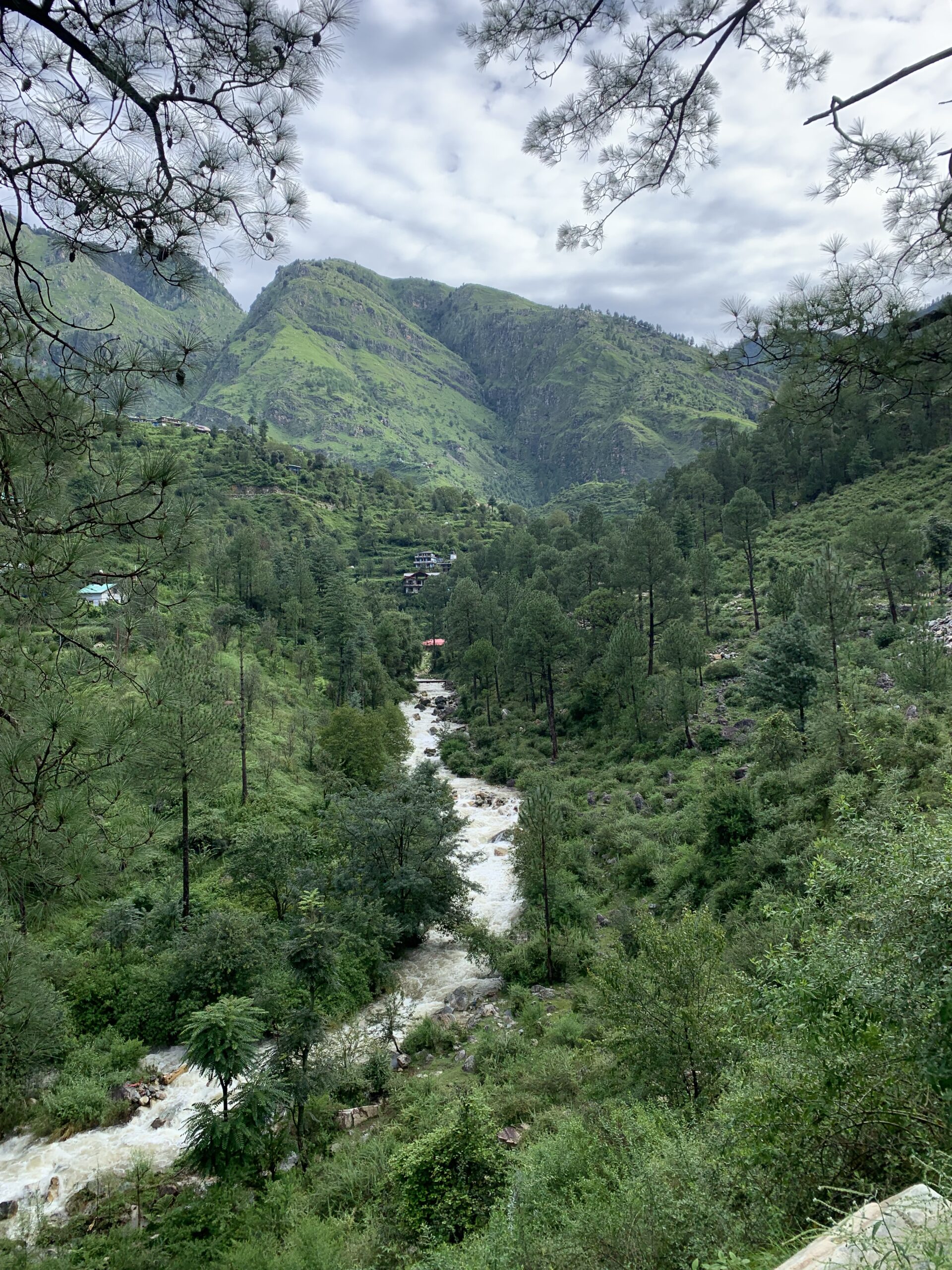
There are no reviews yet.
Be the first to review “Great Himalayan National Park Trek” Cancel reply
Your Rating
Your Review
Save my name, email, and website in this browser for the next time I comment.
- Start End Group (Min-Max) Pricing
How to reach Gushaini
Gushaini is 98.5 Kms from Manali, 51 kms from Bhuntar airport, 267 kms from Chandigarh, 509 kms from Delhi and is linked through Himachal Pradesh State Road Transport Corporation (HPSRTC) and some private travel services.
Related Trips

Pindari Valley Trek
In the heart of Kumaon Himalayas in Uttarakhand lies the lesser-known, captivating Pindari Valley trek. This trek takes you through a variety of landscapes –Tour Details
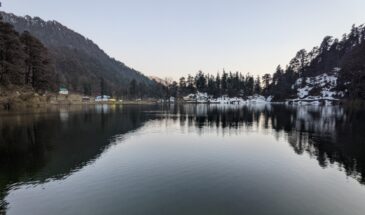
Dodital Darwa Pass
Dodital trek is popular among trekkers for the pristine beauty of the Dodital lake, nestled among mountains at an altitude of 3310 mts above seaTour Details
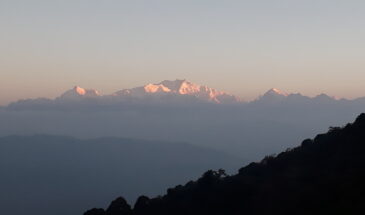
The Singalila Experience is a complete package that gives you a taste of varied outdoor experiences like wildlife spotting, cultural experiences, and hiking throughTour Details
Book your slot in 3 simple steps!
Step 1. Register yourself – Click on this link and fill the Registration form
https://forms.gle/LFy2MRjadMLFaJPFA
Step 2. Make an advance payment –
Make a payment of 50% of the Trek fee to this account
Bank details
RBL Bank Account Number -409000968477 Name – Adventum Escapade private limited Ifsc – RATN0000159 Current account
Send a screenshot of the transfer made to us on WhatsApp 9041139949 or Email [email protected]
Congratulations! You have booked your slot!
For assistance you could contact us on the contact info given in step 3.
COST DETAILS
Located in the Kullu district of Himachal Pradesh, the Great Himalayan National Park is a pristine stretch of Himalayan wilderness with exceptional biological diversity. The area was declared as a National Park in 1999 and in June 2014 was inscribed as a UNESCO World Heritage Site.
The park is home to several species on the endangered list and provides a haven for them. Some of these include the Himalayan Brown Bear, Snow Leopard and the Western Tragopan. Besides these, the park abounds with bird life and is a dream spot for birding groups.
To promote tourism in the area, authorities have marked out a few trails inside the National Park. We are honoured to be able to take you on one such trek. The trek is unique, especially because you get the feeling you are far from any habitation. It is a truly wild experience!
GHNP Area Map
Quick itinerary.
Day 1: Reach Gushaini and start the trek to Rolla (2100 meters)
Day 2: Trek to Shilt (3100 meters)
Day 3: Day hike to Rakhundi Top. Return to Shilt. (3600 meters)
Day 4: Trek to Gushaini
Scheduled Departures 2023
Customize this trek now!
(From 20 March to end of June and 20 September to 10th November)
GHNP Trekker Profile
Cost Details
Cost on request, inclusions:.
- Camping gear
- All meals during the trek
- Sanctuary fee / royalty / permits
- All trekking arrangements – experienced guiding team, camp staff, cook, dining tent and basic camping furniture etc
EXCLUSIONS:
- GST (Taxes)
- Personal porterage (Optional, Rs 4000 per person)
- Tips for guides, cooks, drivers and porters
- Any costs arising out of unforeseen circumstances such as bad weather, landslides, road conditions and any other circumstances beyond our control
- Insurance (Medical, Personal, Evacuation)
We are happy to offer a 50 percent discount to all children aged between 7 -15 years that are accompanied by atleast one parent. This is subject to a maximum of 2 children per trip on first-come-first-served basis.
DAY 01: GUSHAINI – ROLLA
The trek starts along the river, passing the small hamlet of Ropa. At times the trail takes you higher up from the river through beautiful wild groves of walnut trees and then brings you back down to it. Beautiful clear pools of snow melt can be seen through the walk. The forest then starts to thicken up and you get the feeling you are entering a people-free zone – We enter the National Park gate. Continue walking along the river. The trail is pretty much flat all the way to our first camp site at Rolla. The campsite is just beside the river.
Day 02: ROLLA – SHILT
Unlike yesterday the trail today is steep though not long. We start the climb through a stretch of pristine Deodar forest. In parts it is interspersed with mixed foliage making it a perfect habitat for Bharal (Himalayan wild goat) and Monal. Keep a look out for them, you may get lucky!
On arrival at Shilt campsite, which is a clearing in the forest, you have time to just stare and take in the beautiful view which opens up in front of you.
Day 03: SHILT – RAKHUNDI TOP
We have set aside today for a day hike to Rakhundi top, the highest point of the trek. The climb is steep but rewarding. Once at top you can see a 36o degree view of the surrounding National Park area, which includes the Tirthan wildlife area, parts of the Sainj Sanctuary and not to forget the greater Himalayan peaks opening out in front of you. Return to shilt where we camp for another night.
Day 04: SHILT – GUSHAINI
Start the descent downhill retracing your steps all the way down to Gushaini. En-route stop for a lunch break and take in the beauty of the wilderness before exiting the gate and reaching Gushaini. From here we drive back to the hotel to freshen up before the onward journey back home.

No products in the cart.
Great Himalayan National Park
Great himalayan national park ghnp, things to do in the great himalayan national park.

Go on trek in a world heritage site
Multi-day treks Meet the mighty Himalayas and explore GHNP’s wilderness on our 2- to 10-day treks.
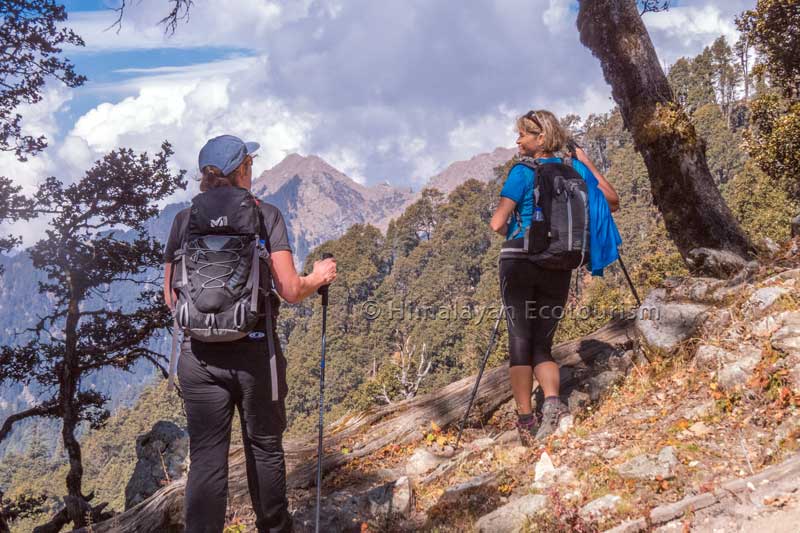
One day to enjoy natural jewels
Day hikes Enjoy the Himalayan nature and quaint villages in one day with one of our day hikes.
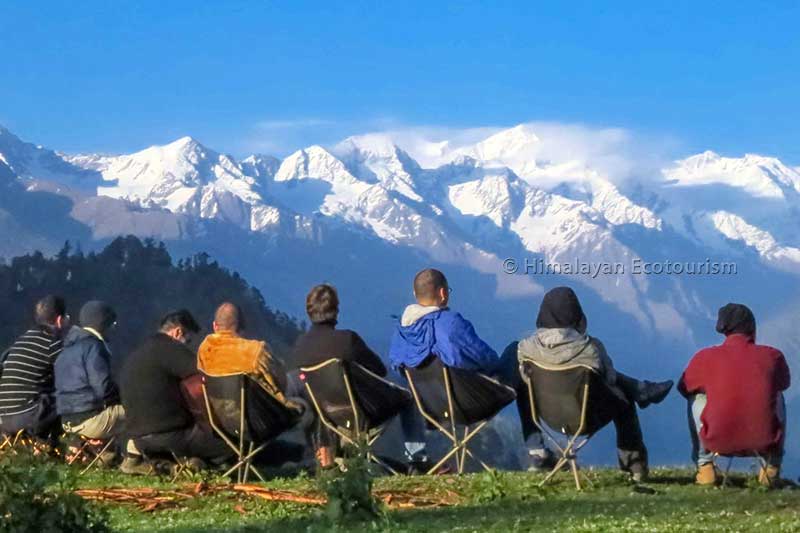
Don't go alone
Fixed Departures Join one of our group treks with fixed date departures to the GHNP.
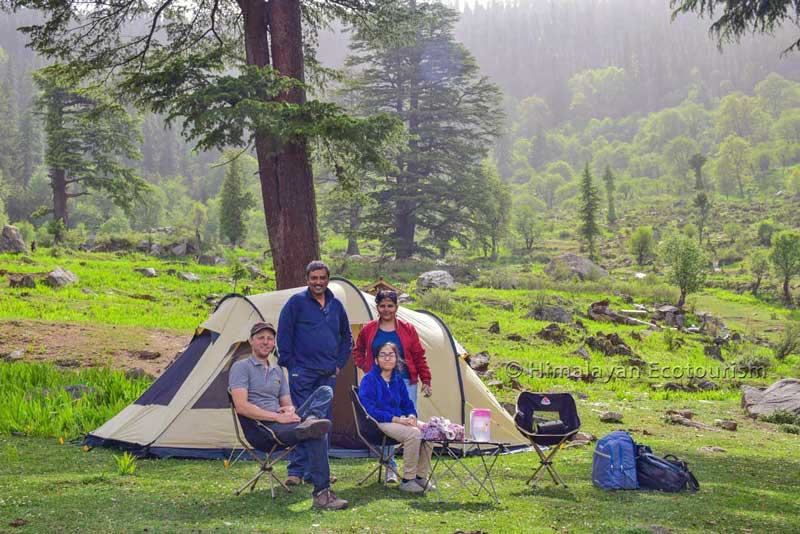
Just to enjoy the wilderness
Easy camping in the wild Try our camping experience in the wilderness for a relaxed outdoors experience.
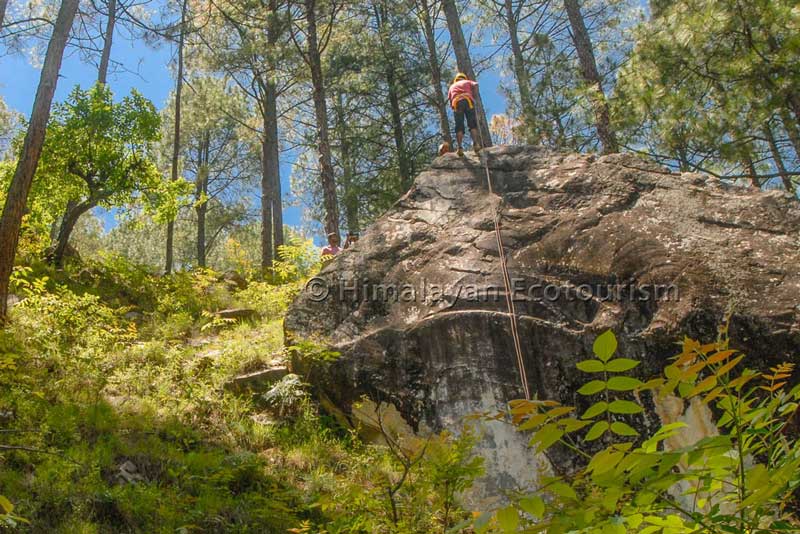
Have fun in the natural elements
Adventure activities Get your adrenaline pumping with our fun activities for adventure lovers, safely of course..
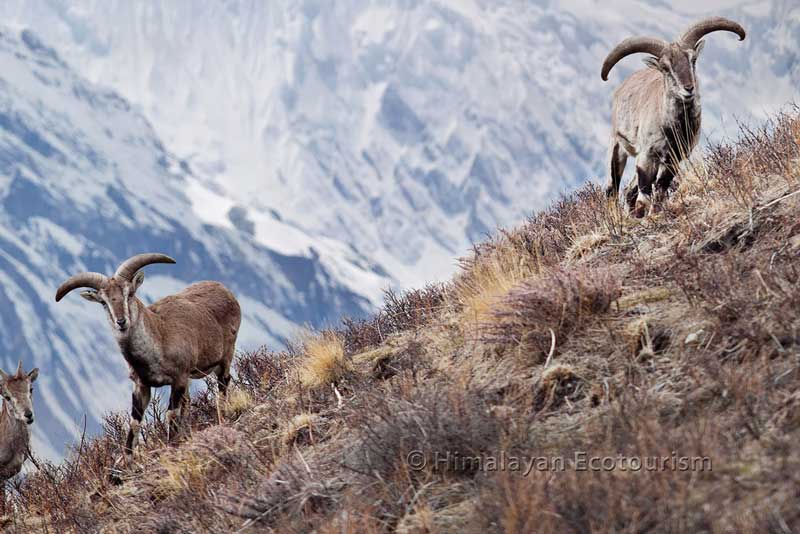
For photographers and nature lovers
Wildlife treks Discover the wildlife of Western Himalayas with customised wildlife treks in the GHNP.
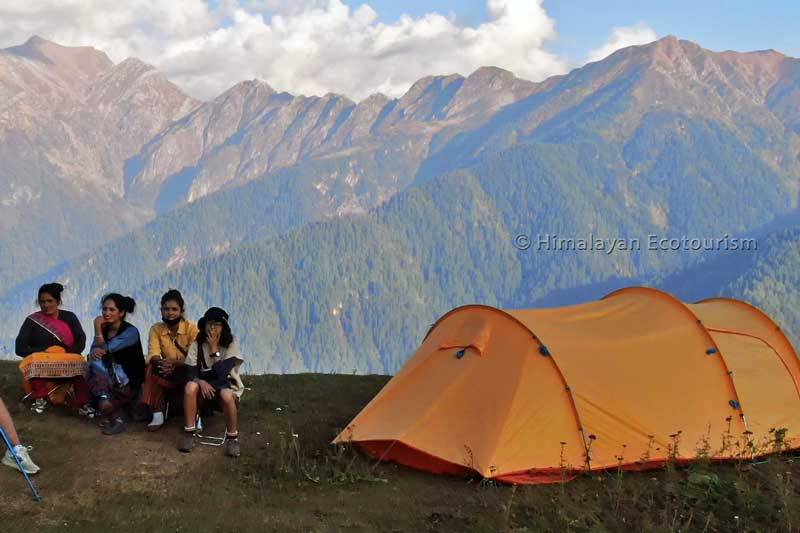
Enjoy an all-women trek !
Women treks Join our women-only treks led by our women staff for camaraderie and adventure in the wild Himalayas.
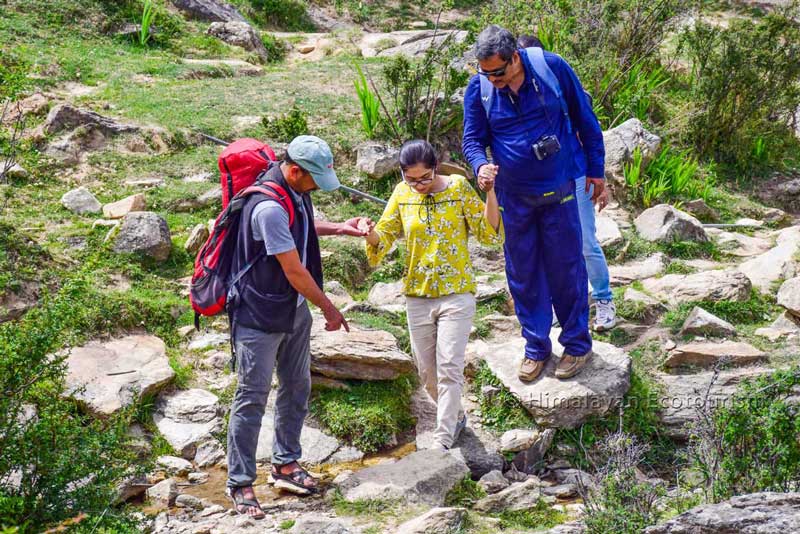
Nature is for everyone
Nature therapy Heal in nature with our forest bathing experience that is accessible to all, including people with disabilities.
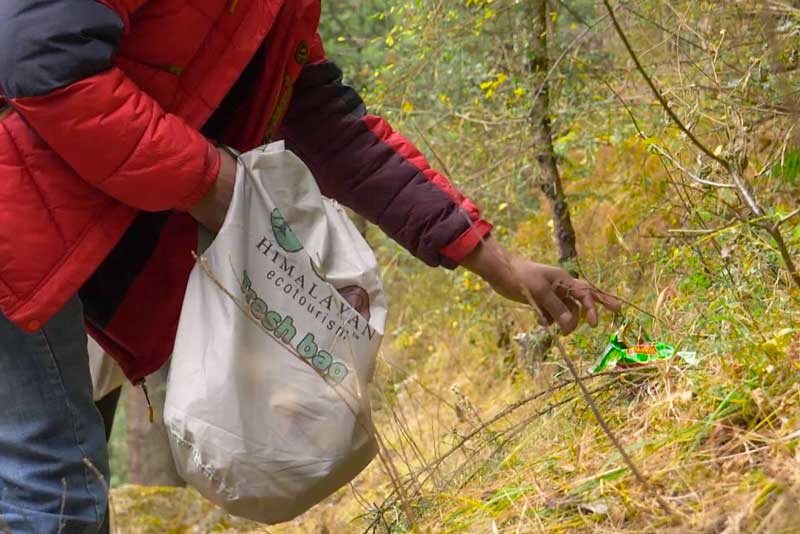
Be a responsible traveler
Travel responsibly Support sustainable development in the Himalayas by trekking with us.
A practical guide to the Great Himalayan National Park
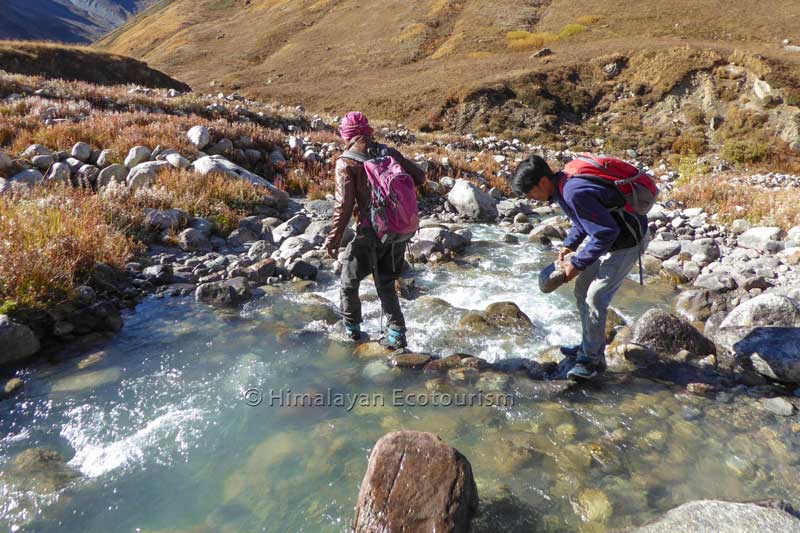
Get yourself ready !
About your trek Find out everything you need to know before going on a trek with us to the GHNP.
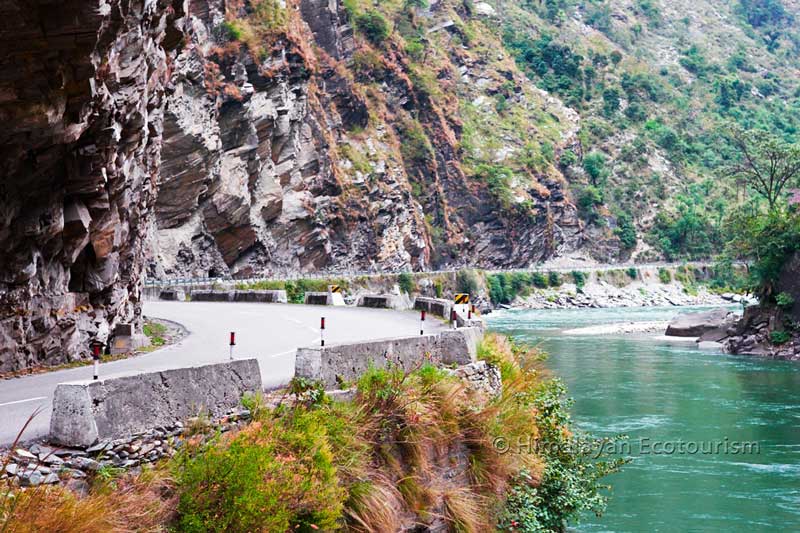
Find out the best way to come
How to reach GHNP ? Know about the best ways to reach Great Himalayan National Park for your trek.
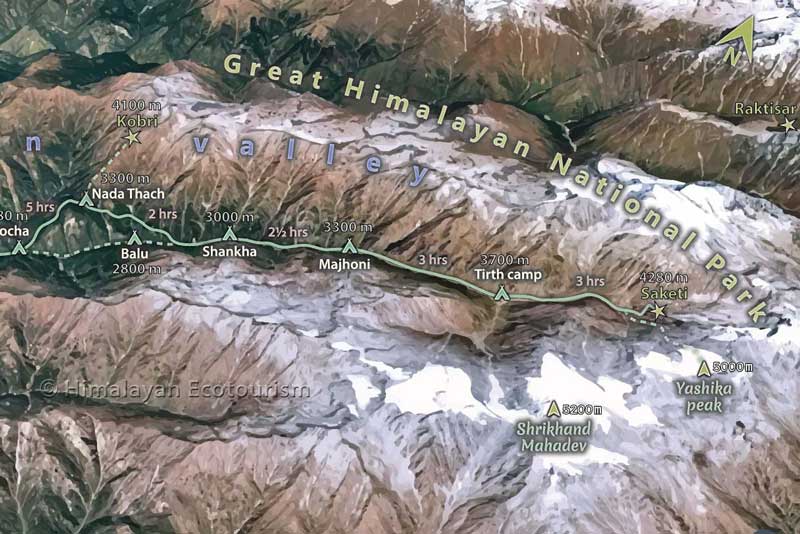
Know about the local geography
Maps of the GHNP Get a quick visual insight of GHNP with trek maps, road maps, and more.
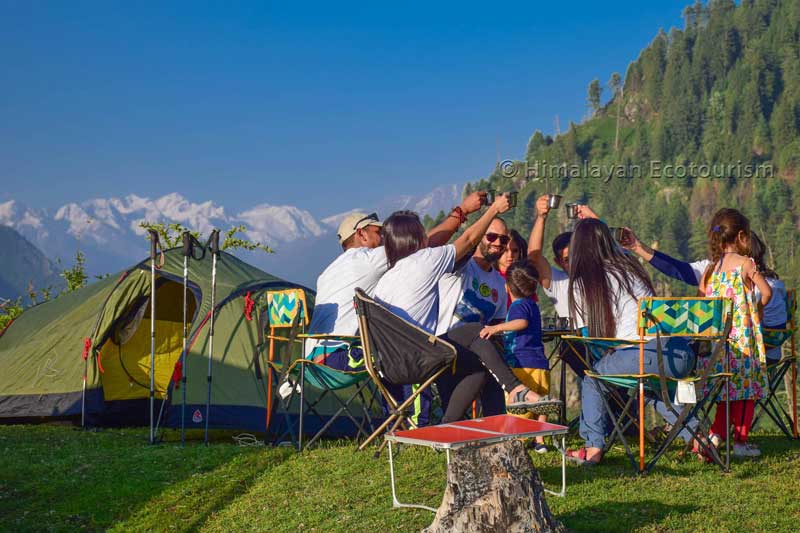
Come when it is best !
Best time to go Discover the best time to visit and trek in GHNP for the best experience.
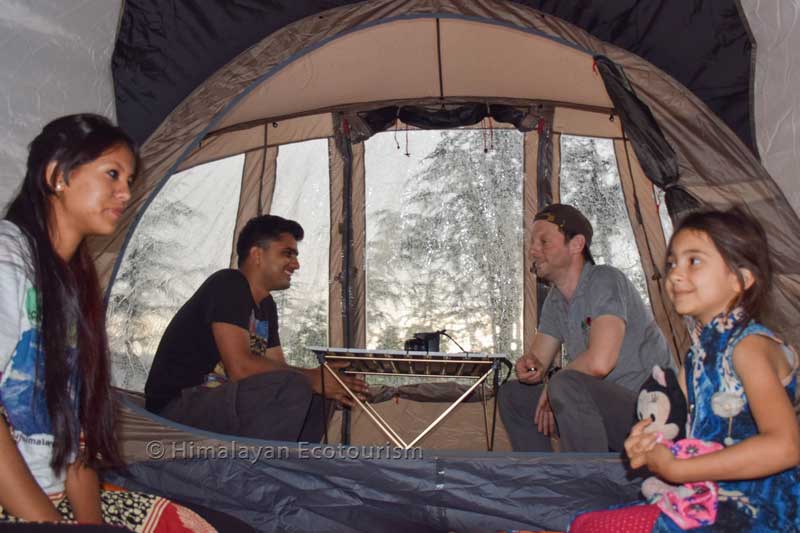
Have the best equipment for your trek
Your trekking equipment Select your equipment for your trek for a comfortable trekking experience.
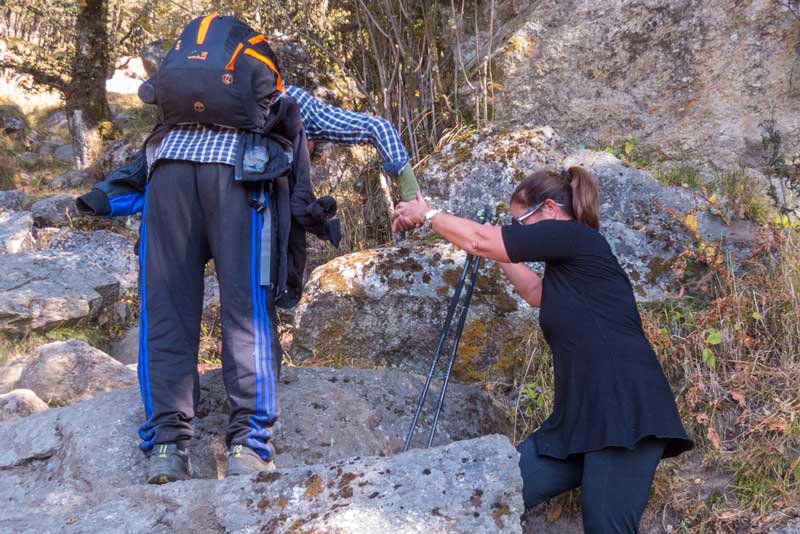
Enjoy our hospitality
Our services Learn more about the services we offer before, during, and after your trek.
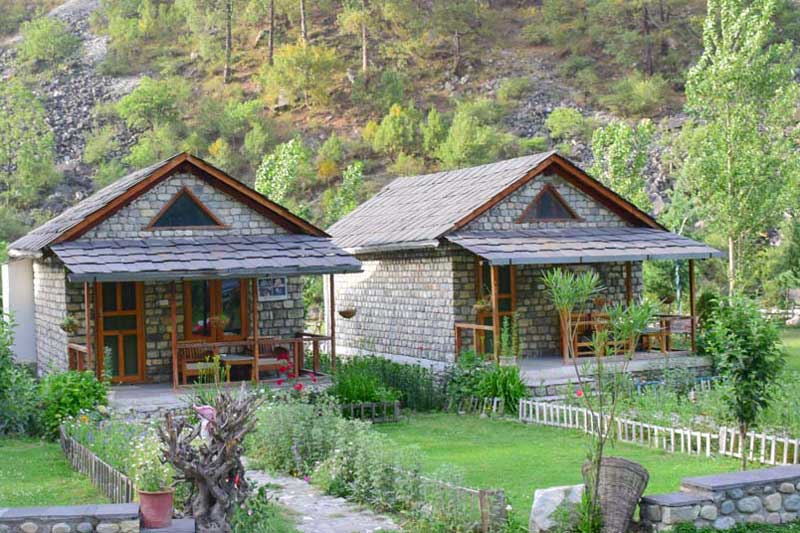
Homestay in the Tirthan valley
Homestay Choose a homestay to meet local people and experience the culture around GHNP.
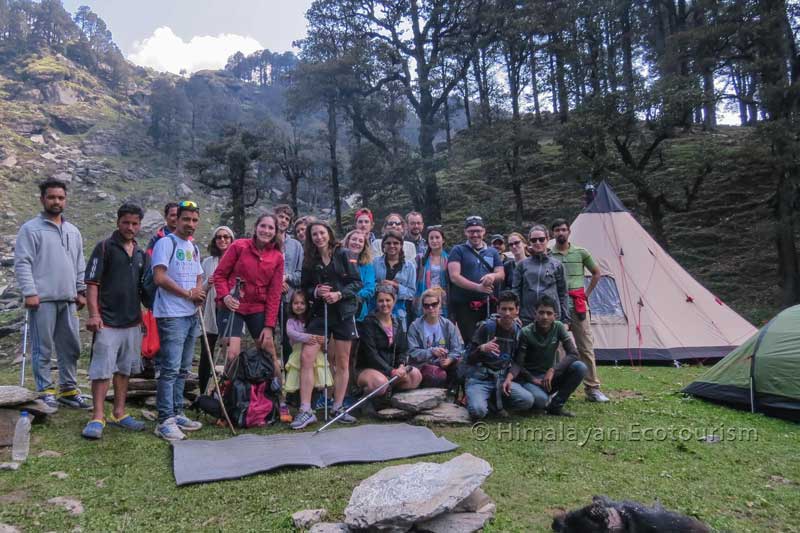
Corporate events near the GHNP
Corporate events Offer your team a rejuvenating time in the Himalayas by organising an event with us.
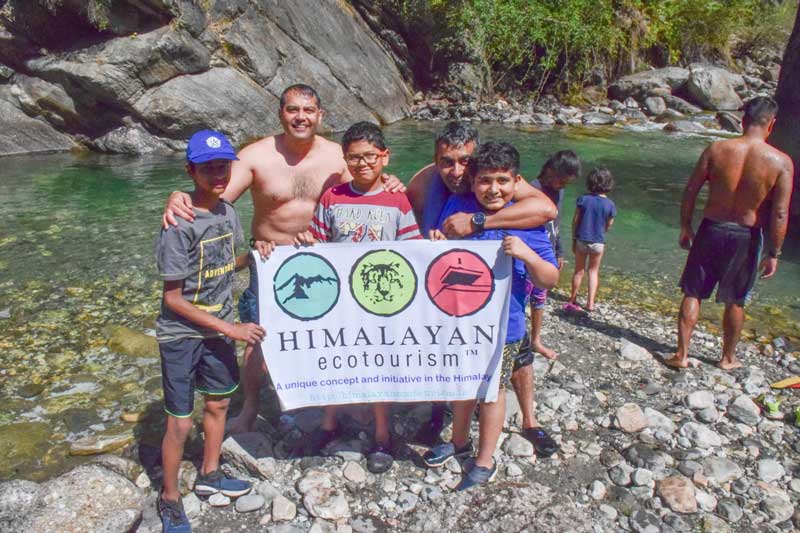
Go with a social enterprise
Why to choose us? Support sustainable development by trekking and travelling with a social enterprise.
About the Great Himalayan National Park
The Great Himalayan National Park is located in the Western Himalayas, close to Kullu and Manali in Himachal Pradesh. GHNP is part of the Great Himalayan National Park Conservation Area (GHNPCA) and a UNESCO World Heritage Site.
The region is of great interest to conservationists and naturalists because of its value as a biodiversity hotspot and for the rare, endemic, and endangered birds and animals found in the Great Himalayan National Park.
GHNP offers an exciting and memorable experience for trekkers, hikers, campers, and bird/wildlife enthusiasts with stunning vistas of the lush Himalayan mountains and some of the best Himalayan treks. Visitors also have the opportunity to witness local traditions, culture, and life in the Himalayan villages in the Ecozone.
Trekking is the only way to enjoy and explore the Great Himalayan National Park. There are several trekking and hiking routes in the Great Himalayan National Park. A short 2 day trek is a gentle introduction to the park. Longer treks of upto 9 days take you deep into the heart of the park to the source of rivers.
Himalayan Ecotourism takes you for amazing treks in the Great Himalayan National Park (GHNP). Your trekking crew are members of the local cooperative that we have encouraged and supported from its creation. Your visit actually supports conservation of the Great Himalayan National Park.
Since its inception in April 2014, Himalayan Ecotourism has been operating towards the preservation of the Himalayan ecosystem by engaging the local community in managing their invaluable resources.
For non-trekkers who want to enjoy the experience of camping in the Himalayas we also offer “Night under the stars” in the ecozone of the GHNP.
For adventure seekers we offer activities like rappelling, river crossing, rock climbing and fishing!
Himalayan Ecotourism also organizes exploration tours around the Great Himalayan National Park specially designed for birdwatchers and for people interested in the rich traditions and culture of the Himalayas.
Great Himalayan National Park’s Ecozone
The creation of GHNPCA also saw the creation of the Ecozone, which acts as a buffer zone between the Park and the rest of the region. It is a designated area of 5km radius around the Park where the villages are located.
The majority of inhabitants of the Ecozone are agriculturalists. They are almost self-sufficient for their own subsistence. They grow wheat, corn, rajma, and many vegetables and spices. They also grow fruits that are sold to larger markets in India. The region is known for its apples and apricots.
Many of the villagers have large herds of sheep and goats, which are used for wool and meat. Goats are often offered to the local Devatas (gods) on special occasions.
Since the creation of GHNP, the local community’s access to the Park has been prohibited. The Park used to be an important source of livelihood for local communities where they collected medicinal plants and wood and grazed their cattle. Hence, the creation of the Park resulted in an important loss of income for the local community, which is being addressed through various initiatives.
Efforts are underway to protect the local culture and traditional livelihood with emphasis on the development of the villages. The local communities are also encouraged to participate actively in the conservation and protection of the Park.
Himalayan Ecotourism is facilitating the creation and implementation of alternative sources of income to secure the welfare of the locals while also protecting the Park.
We work closely with the local communities to economically empower them through sustainable development models such as the cooperative that operates the treks in the Himalayas, camping, and adventure activities in the Great Himalayan National Park. Read more about our work here .
Great Himalayan National Park Videos
TREKKING IN THE GHNP All you need to know for planning your trek in the GHNP with us
TREK IN GHNP BY JANISHA A moving video narrated by Janisha among our cooperative members.
WOMEN TREK TO THE GHNP Our women empowerment program on trek !
Great Himalayan National Park conservation area
The Great Himalayan National Park (GHNP) is a World Heritage Site (WHS).
The Ecozone is the buffer zone between the Park and the rest of the region. It comprises villages and lands within a 5km radius around the Park. Villages located in the Ecozone are supposed to be closely associated to the protection of the park. Their culture and traditional livelihood have to be protected and a special emphasis is normally given to the development of the villages.
The majority of inhabitants of the Ecozone are agriculturalists ; they are almost self-sufficient for their own subsistence. They grow wheat, corn, rajma, (organic beans) and many vegetables and spices. They also grow fruits that are sold to larger markets in India. The region is well known for its apples and apricots.
Many of the villagers have large herds of sheep and goats. Both are used for wool and for their meat. Goats are often offered to the local Devatas (gods) on special occasions and also served as one of all-time-favourite delicacies of the region.
Since the creation of the Great Himalayan National Park, local community’s access to the Park has been prohibited. The park used to be an important source of livelihood for local communities be it by collecting medicinal plants, wood, or grazing their cattle.
Hence creation of the Park resulted in an important loss of income for the local community. Himalayan Ecotourism social and environmental objectives aim at facilitating availability of alternative sources of income so that welfare of the locals and protection of the Park are ensured.
The GHNP and the Tirthan Valley Ecozone are a hub of biodiversity. It only takes a glance to spot exceptional species of birds. The more patient and experienced naturalists can see the rare and ‘difficult-to-spot’ mammals. Many are on the Red List of threatened species. The process of conservation of these species by the Park is essential to their survival.
A trekker must respect the environment he travels in. The main cause of extinction of animal and plant species is the destruction of the ecosystems. The GHNP and the Ecozone community are dedicated to protect and manage these exceptional natural environments.

MAP OF CONSERVATION AREA, TREKS AND HIKES
Great Himalayan National Park (GHNP) consists of 3 valleys: Tirthan, Sainj and Jiwa Nala valley
Best time to visit Great Himalayan National Park
Best time to visit Great Himalayan National Park GHNP is April, May, June , and then October and November .
Avoid the monsoon between July and August as it rains a lot and the paths become slippery and there are chances of landslides.
Avoid the winter months of December to March. GHNP receives heavy snowfall in winter.
Best time to go
How to reach Great Himalayan National Park
The ecozone of the Great Himalayan National Park is just 1 hour off the main Delhi-Kullu-Manali road. There are regular overnight Volvo buses from Delhi and Chandigarh to Kullu and Manali.
Inform the conductor of the bus that you need to be dropped at Aut town just after the tunnel. We can arrange a taxi to pick you up from Aut from where it is 1.5 hours to Gushaini – the main starting point for treks to the Great Himalayan National Park.
See next section for more information and maps for getting to GHNP.
Traveling to GHNP
A bus is the preferred option to travel from Delhi to GHNP via Aut. There are comfortable Volvo buses (min Rs 1000) from Delhi to Manali. Most of the busses start in the evening from Delhi. You have to get off the bus at Aut early morning, and take a taxi (about Rs 1000) or local bus to Banjar or Sainj. Or we can arrange your transportation from Aut by sending our own taxi.
You can also come from Shimla going through Jalori pass (Shimla – Banjar, 8 hours drive). Be aware that Jalori pass is closed in winter because of snow (December to March).
If you come by your own vehicle, the shortest route goes through Chandigarh, Bilaspur, Mandi and Aut. Then you need to move to Banjar or Sainj, the two main entries to the Park (Delhi – Banjar, 12 hours). The road to GHNP diverts before reaching Aut. Just before Aut, there is a tunnel (the only tunnel on the road from Delhi). Do not enter the tunnel. Just at the entrance of the tunnel there is a smaller road on the right. Take this one. After crossing a dam and then a bridge, either you continue straight to Sainj (for Sainj valley), or if you need to go to Banjar (for Tirthan valley), you need to cross the next bridge on your right to reach the small town of Larji. Turn right after the bridge and continue straight to Banjar (about 20 km from Larji).
Map of the road to the GHNP
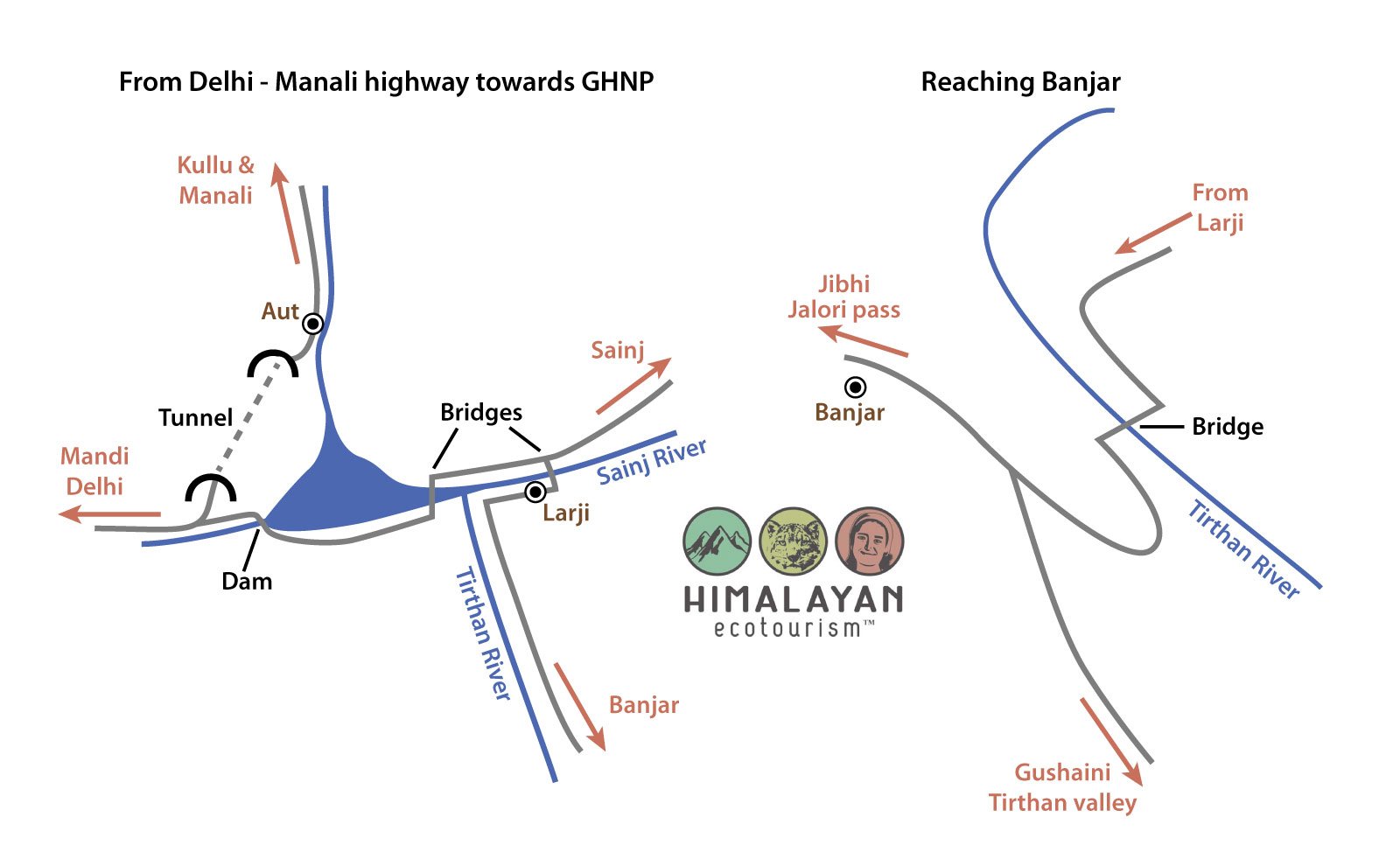
Road map of the Great Himalayan National Park showing how to get to GHNP
Flora and fauna in Great Himalayan National Park
Apart from the sublime beauty of the Himalayan mountain range that the Great Himalayan National Park is famous for, you will encounter an array of flora including medicinal plants such as henbane and purple Jerusalem sage while trekking in GHNP. The vegetation varies based on the altitude and includes forests with pine, deodar, oak, and horse chestnut trees as well as sprawling alpine meadows. The flora of GHNP also comprises rhododendrons, fungi, and shrubs.
The Great Himalayan National Park is home to over 31 species of mammals, 209 species of birds, and a variety of invertebrates, amphibians, and reptiles! This abundance of wildlife is because of the different ecosystems that fall within the protected area and that are located at different altitudes ranging from 1800m to above 6000m.
The mountains are home to the Himalayan Black Bear, the Himalayan Tahr, the Himalayan Brown Bear, and the Phantom of the Mountains—the Snow Leopard. Himachal Pradesh’s state bird Western Tragopan, or Jujurana, which is an elusive and endangered species, is found in these forests. There are other pheasants too such as the monal, koklass, white-crested kajeel, and cheer pheasant.
Birders have the opportunity to spot a variety of other birds of the Himalayas here, which includes the:
- Long-tailed Minivets,
- Yellow-bellied Fantails,
- Wallcreepers,
- White-collared and Gray-winged blackbirds,
- variegated laughing thrush,
- Scaly-breasted Wren Babbler,
- Spectacled Finch and Golden Bush Robin,
- Blue-capped Redstart,
- Black-throated Thrush,
- Black-throated Accentor,
- Little Forktail,
- Crested Kingfisher,
- Blue Whistling Thrush,
- Yellow-billed Magpie,
- Greyheaded and Black-crowned flycatcher-warblers,
- Bar-tailed Treecreeper,
- Lammergeiers,
- Himalayan Griffon Vultures
- Golden Eagles.
Great Himalayan National Park stay
While in the Great Himalayan National Park, you can only stay in tents as there are no guest houses, hotels, or forest rest houses within the Park premises.
During all our treks (and when camping), you will be sleeping in imported, light-weight European tents with sleeping mats and sleeping bags. The equipment is secure and comfortable and built for even harsh weather conditions. The tents are carried by our porters who are part of the staff that accompanies all treks.
See the next section for stay options nearby the Great Himalayan National Park.
Great Himalayan National Park hotels
Before or after your trek in GHNP, you can find accommodation outside the Park. You have a choice of homestays and guesthouses in the region. With the recent development (post-COVID) that have happened in the Tirthan valley, you can also find hotels in the vicinity of the Park.
The GHNP office in Sai Ropa, Tirthan Valley, has a government-managed guesthouse with a couple of rooms and a dormitory. It is only 15 minutes away from the start of the trek in Gushaini.
We can arrange your stay at guesthouses or homestays at the start and end of the trek depending on your preference and budget. The budget could range from INR 1,500 to INR 12,000 for a double occupancy room.
For accommodation in Great Himalayan National Park : a list of local homestays .
Great Himalayan National Park GHNP map
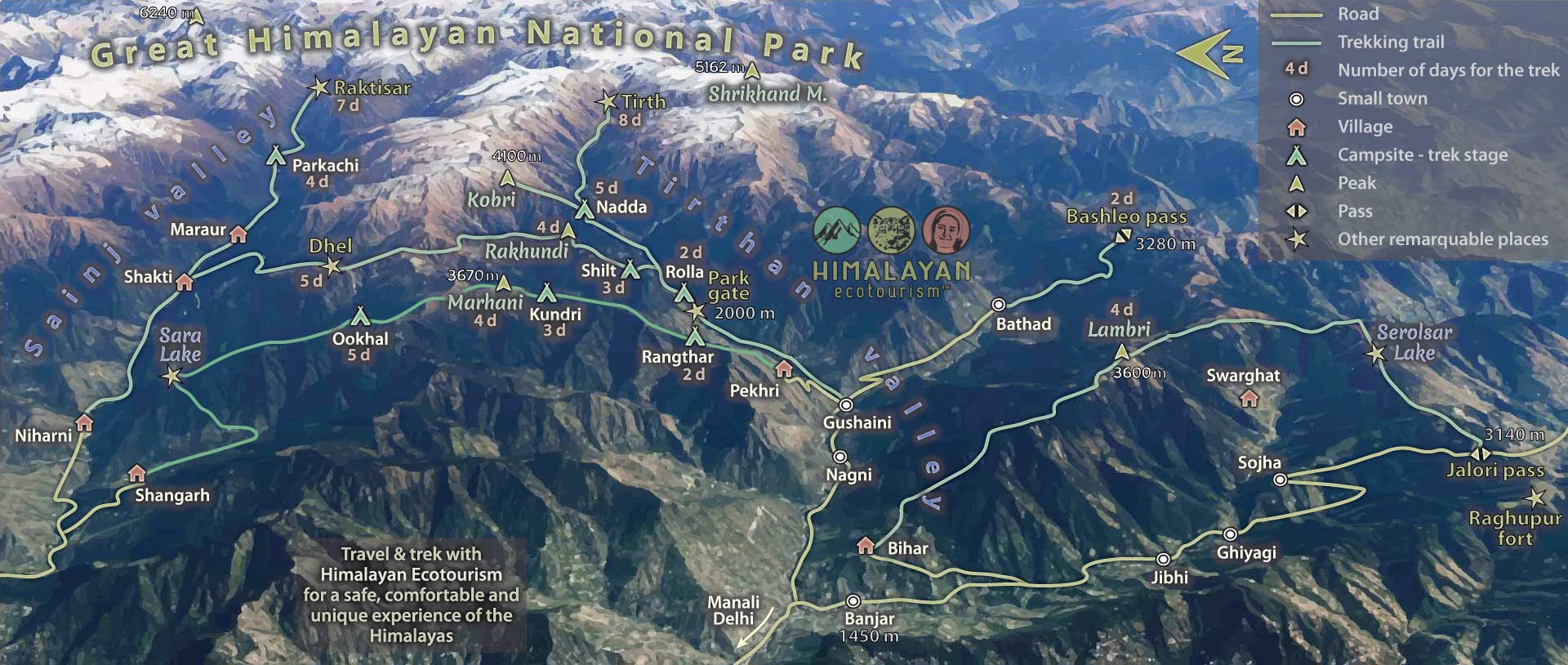
Great Himalayan National Park map is shown above. It shows the main trek trails in the Great Himalayan National Park. For each trek, the map informs about the required number of days.
FAQs about the GHNP
Best time to visit ghnp for trekking.
April to June and then September to November.
HOW TO REACH GHNP BY BUS
The best is to go to GHNP by Volvo bus from Delhi to Manali and get off the bus at Aut.
ARE KIDS ALLOWES ON GHNP TREK
Kids from the age of 6 are welcome on our treks. Below this age please inquire.
FITNESS REQUIRED FOR GHNP TREKS
Our short and easy-level treks (2 to 3 days) are designed for everyone with average fitness. Check the profile of our treks to know more about the demands of each trek.
WHAT'S INCLUDING IN THE TREK COST
Please specify the dates, budget, the number of people, and food preferences and we will help arrange the right accommodation for you.
The trek cost of our trek packages includes the wages of trekking staff, food, camping and other equipment, trekking permits, and a small fee toward our reforestation program.
GHNP visitors’ experiences
The GHNP visit is an amazing place to experience rich flora and fauna of Himalayas. This provided me an opportunity to truly understand what a Global Biodiversity Hotspot means. This place is birders paradise as many species of Pheasants can be seen here commonly. Himalayan Monal is the most abundant of them, Koklass and Kaleej also add in to the beauty of the place. The forest here is so alive that we were able to see signs of wildlife everywhere.
To my astonishment the hospitality of the Himalayan Ecotourism was amazing. It was like having a five star luxury at 3000m above sea level. The people here are compassionate towards their guest as well as towards their environment.
A sensible tourist with compassion towards nature must visit this place to experience amalgamation of nature and culture of Himalayan People. This is truly a Land of Nature God.
Girish Jathar

Sign In Here!
Log into your account in just a few simple steps.
Register Now!
Join the SetSail community today & set up a free account.
Great Himalayan National Park
₹ 14,429 onwards
Label : Top Attraction
Tags : National Park
Timings : 10:00 AM - 5:30 PM
Time Required : 3-4 hrs
Entry Fee for Great Himalayan National Park : Indian Nationals: INR 50, Foreign Nationals: INR 200, Indian Students: INR 30, Foreign Students: INR 100
Camping Charges : 2 Persons Tent/ per day: INR 100 3 Persons Tent/ per day: INR 150 4 Persons Tent/ per day: INR 200 Above 4 Persons Tent/Day: INR 500 Toilet Tent/Day: INR 100
Best Time to Visit : April to June
Planning a Trip? Ask Your Question

Jawaharlal Nehru Great Himalayan National Park
Great himalayan national park, kullu overview.
Great Himalayan National Park located Kullu region of Himachal Pradesh, is home to more than 375 species of fauna, 31 species of mammals and 181 species of birds. The Great Himalayan National Park received the status of a national park in 1999. This beautiful location of the national park becomes all the more attractive due to the Deodar and Oak trees.
The secluded location of the park has made sure that the villages inside the park have a culture of their own. Every village inside has a deity of its own. There are also some fairs organized here during April, May, August, and September. You need to obtain a permit to visit the Great Himalayan National Park. The permits for the core zone of the park can be obtained at the Shamshi head office and the range offices at Ropa in Sainj Valley and Shairopa in Tirthan Valley. There are different levels of trekking that can be done inside GHNP. Moderate day-long treks to difficult multi-day treks are organized on all the four valleys of the park including Tirthan, Jwar Nala, Parvati and Sainj. It is compulsory for the tourists to seek prior permission from the park officials for treks held on different days.
Must Know Before You Visit Great Himalayan National Park
Tips to Visit : 1. People visiting the Great Himalayan National Park for more than a day are advised to obtain medical insurance covering emergency medical treatments. 2. The trekkers should hire certified guides and porters. 3. Beware of prickly plants and do not disturb the wild animals in the park. 4. Do not litter inside the park. 5. Obtain permission before photographing the tribals and villagers living in the ecozone. 6. Wear modest attire while visiting the park. 7. Smoking is forbidden inside the Great Himalayan National Park.
Great Himalayan National Park Highlights
1. seasonal activities.

2. Ecozone Activities

Kullu Travel Packages
Compare quotes from upto 3 travel agents for free
Best Manali Tour Package - Free Kufri Sightseeing Trip
Breathtaking kullu manali family tour package, beautiful manali and kullu tour package, manali kasol tour package - night camping, manali tour packages for couple - 3 nights 4 days, romantic kullu manali budget honeymoon package, top hotel collections.

Cheap Hotels
Near KUU Airport
Top Hotels Near Great Himalayan National Park
9.1 (80 reviews)
53 kms
₹ 1,400 onwards
7.6 (72 reviews)
41 kms
₹ 900 onwards
8.4 (65 reviews)
₹ 3,999 onwards
Great Himalayan National Park Reviews
Rohit Shroff
Have a Question on Great Himalayan National Park?

Popular Questions And Answers on Great Himalayan National Park
Q. Can we stay national park on our cooking equipments and can we make a dinner along you ?
Q. Can we visit national park on our own or is it mandatory to hire guides and cooks along if you planning to trek? Some people are even charging 10,000 per person for the trekking and all which I am finding lil too much. Can we trek on our own?
Other Top Ranking Places In Kullu
Nearby places.

Related Posts

Sightseeing
Things to Do in Kullu for a Perfect Hillside Vacation

How To Reach Malana and Things To Do Around It!

Paragliding and River Rafting To Resume in Kullu, Operators to Follow Rules or Face Penalisation

Kullu: A romantic get away destination

Kullu Dussehra 2024 - Dates, Celebrations and Festivities
Similar Places

Get the best offers on Travel Packages
Compare package quotes from top travel agents
Compare upto 3 quotes for free
- India (+91)
*Final prices will be shared by our partner agents based on your requirements.
Log in to your account
Welcome to holidify.
Forget Password?
Share this page
slow • solo • sustainable

Great Himalayan National Park: A Hike to Hippo Waterfall and the Park’s Gate
The Great Himalayan National Park is located in the Kullu district of Himachal Pradesh. It spans some of the popular destinations in Himachal Pradesh including Parvati Valley and Tirthan Valley amidst others – though it still has not been explored well by the general public. However, the Great Himalayan National Park has great routes for serious trekkers. These treks range from moderate to difficult and span across several days.
To go trekking in the Great Himalayan National Park you require GHNP permits . These can be obtained at the GHNP offices at Shamshi, Shairopa and Ropa villages.

Not many know, however, that there are several GHNP day hikes that beginner trekkers can undertake very easily and witness the magic of virgin forests of the Great Himalayan National Park. The two most popular Great Himalayan National Park day hikes include the Chhoie Waterfall Hike, as well as the GHNP gate hike. We’ll leave a blog on Chhoie Waterfall hike for some other day. For today, let’s talk about how you can do one of the most beautiful day hikes in Tirthan Valley: the GHNP gate trek.
What's In Here
How to reach the Great Himalayan National Park gate
The hike to the GHNP gate is one of the easiest GHNP treks. The trek begins from Gushaini village in Tirthan Valley.
To reach Great Himalayan National Park from Delhi, take an overnight bus to Bhuntar and get down at Aut. From Aut, hop on to a local bus to Gushaini.

Gushaini to GHNP gate trek starting point is 3 kilometres away. Follow the dirt road diverting from the Gushaini market, that goes on the right side of the river. There is no landmark for the starting point, but a small shrine beside the road on a curve. Park your vehicle somewhere here, and start following the trail going downhill towards the river. Lo, and behold! You have begun the Great Himalayan National Park gate trek.
Hippo Waterfall and The Way Beyond
The Great Himalayan National Park trek trail is beautiful and goes through a mesmerising forest, along the Tirthan river. You also pass a few small villages on the way – with houses built in the traditional Kath-Kuni architectural style . At the midpoint of the trek comes the Darakhali mobile point which is the last place you will receive mobile network. It has a small wooden gazebo overlooking snowcapped mountains and makes for a beautiful little rest stop!

Just a few meters ahead of Darakhali, is a diversion that often goes amiss. A small, obscure wooden plank hanging on a tree with the words “GHNP” painted across it is the only indication you will receive to find the right way. As you walk further and cross several bridges, you finally reach the Hippo Waterfall right at the end of the GHNP gate trek.

The Hippo Waterfall is named so because the water gushes down on a giant brown-grey rock that is unmissably similar to a hippopotamus! With the water glistening on the rock surface, it looks exactly like a hippo bathing in a pond. Locally, this place is called “Chuli Chaw”. In the local Pahari dialect of this region, chuli means the hollow between two palms when hands are joined together, and chaw means a waterfall. It is named so because the water gushes through a slit in the rock above, seeming like it is flowing through a chuli !
Right after the Hippo Waterfall or Chuli Chaw is the gate that officially welcomes you to the Great Himalayan National Park, marking the end of your Tirthan Valley day hike. Inside the gate are a rest house, bathrooms and a fire pit accessible to the general public. Beyond the gate, one can also opt to continue hiking towards Rolla which is just 2 kilometres from the GHNP entry gate. The hike to Rolla in GHNP takes a maximum of 1 hour from the entry gate. (I couldn’t go further because I started the trek at noon, and reached the entry gate at 3 pm).

GHNP Gate Trek: All You Need to Know
- This is one of the easiest GHNP treks possible.
- No permit is required to do the GHNP gate trek.
- The GHNP gate hike is about 3 hours long and is an easy, level walk.
- Mobile network is available in GHNP up till the mobile point at Darakhali (midpoint of the trek).
- Entry is free for this hike and there is no Great Himalayan National Park trek cost.
- There are bathrooms available at the GHNP gate. Fire pits and rest houses are also available here. Luxury in the middle of a forest!
- Make sure you wear trekking boots and carry sufficient water. There are two water sources on the trek.
- Small shops selling chai and biscuits can be found at the very beginning of the hike.

For more adventures from the Great Himalayan National Park and elsewhere, follow me on Instagram !

Share this:
- Click to print (Opens in new window)
- Click to share on Facebook (Opens in new window)
- Click to share on WhatsApp (Opens in new window)
- Click to share on Twitter (Opens in new window)
- Click to share on LinkedIn (Opens in new window)
- Click to share on Reddit (Opens in new window)
- Click to share on Pinterest (Opens in new window)
- Click to share on Tumblr (Opens in new window)
- Click to email this to a friend (Opens in new window)
A twenty-something solo adventurer, Avantika finds comfort in learning about various cultures, its people and listening to age-old folk tales. When not on the road, she can be found cuddled up with her dog in her room, with a book in her hand.

Chehni Kothi, The Tower Temple of Tirthan Valley

Shilha Village: Offbeat Parvati Valley
You may also like.

Tirthan Valley Day Hikes: 10 Trails You Should Consider

Trapped in Rajgundha Valley: 4 Days Through Hell and Back

Vansh Tiwari
Hi Avantika, the article is really informative. When the last time I went to Jibhi, I was planning to go to GHNP but somehow the plan got canceled. This article just reminded me that GHNP is still left to be explored. Looks like, you had visited the GHNP during the summers?
Thanks a lot for your kind words, Vansh! GHNP is indeed paradise. I went in autumn
Amita Chaturvedi
Spectacular pics,looks beautiful place
Hey Avantika, thanks a lot for sharing this information. Even more excited to go there than I was earlier, thanks to the article!
Is the trek to the gate one which can be taken alone, or would you recommend finding a guide for the same?
Hey Anuj, so glad you found this information useful! Sorry I couldn’t respond earlier – but I think this one can be done by yourself, no need of a guide! If you loose your way, there’s plenty village houses en route. If you plan to venture beyond the gate, I’d recommend tsking a guide. Hope this helps!
Leave a Reply Cancel reply

Harstuff Travel
Adventure & Budget Travelling in India
Rolla Trek in Great Himalayan National Park
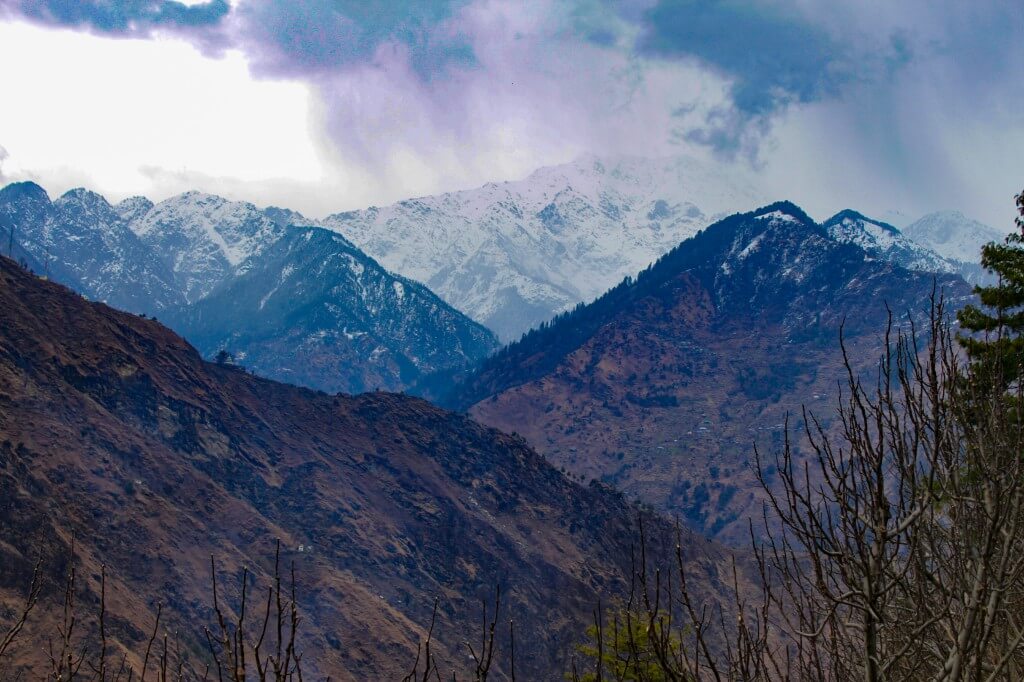
We had already made up our mind to visit this tiny hamlet, Gushaini and do the Rolla Trek in the Great Himalayan National Park after suggesting by one of the locals in Jibhi, who was also the campsite owner. Though, few of the group members were refusing as they were not interested to test their physical fitness. Fortunately, I convinced all the members and we headed towards Gushaini from Jibhi.
Read Part 1 – Exploring Jibhi & Jalori Pass
Reaching Gushaini
Gushaini is around 20 km from Jibhi and the route bifurcates from Banjar. We drove to Banjar and took the right turn to enter the region of Tirthan Valley. The scenes changed a bit and it became more gorgeous. The road was along the Tirthan river having tall pines, the valley turned narrow, the forest turned dense and the best thing was that it was lesser crowded as compared to Jibhi. Soon we reached the entry gate of the Great Himalayan National Park at Sai Ropa. The place has a forest office along with a rest house and a dormitory. We talked to the forest ranger and he told us that one has to acquire permits and a guide to trek beyond Rolla but we had planned only up to Rolla for which there were no permits and guide required.
Since we were already late, we quickly got into our car and moved towards Gushaini. Amidst the way, we found several riverside homestays and camp stays which seemed perfect for a soothing experience. In half an hour, we reached the village and got ready for the trek. We took our belongings (raincoat and other essentials), purchased some eatables (biscuits, chocolates, and juices), and enquired about the route from locals. Some locals also suggested that we shouldn’t go there as we were quite late but we thought that we could make up to Rolla and come back before dark by moving fast, hence we began.
Starting the trek
The distance from Gushaini to Rolla is 8 km and is an easy trek however it becomes moderate after passing the entry gate as told by some locals. The initial route was quite wide as it seemed like a road but it was full of mud and wet dirt. We walked around a km and found out that the route was closed due to a landslide. Luckily, we found one local guy who was going to a nearby village through the same route. We followed him but it was not easy as the terrain was steep due to shortcuts and he was walking at his normal speed which was a bit fast for all of us. He made us do that 2 km hike in half an hour.
After that, we were back on the trail and now there was no local villager going further. We were on our own. The trail became narrow and the forest was quite virgin. We continued the trek without taking any rest and reached another tiny village and decided to halt there to have some refreshments. There were a few cafes from one can get a mesmerizing view of the entire valley. Having tea and pakoras in those cute wooden cafes were a treat to us.
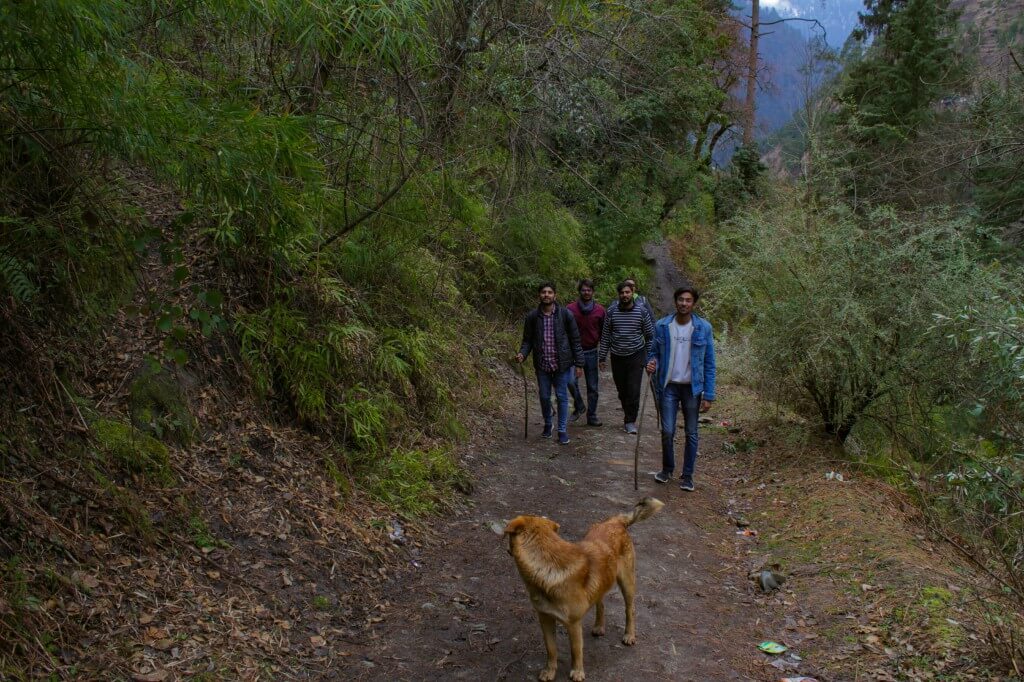
We resumed the trek after having delicious pakoras. The trail started getting steeper and as we were moving towards Rolla, the forest was also getting denser. The snowline was also becoming visible. Now there was no one on the trail except us. We hiked all the way to Rolla by singing songs and having fun and finally reached the gate by 6 PM. There was no one in the forest rest house. We spent some time there and then started descending down after clicking some photos.
As we began, it started raining but we decided to not stop as it was getting darker. So we put on our ponchos/raincoats, took a sip of old monk and continued the descent in the rain. The rain was mild so it was not a problem. In just half an hour, it got completely dark and we were alone in the forest. It was a pure thrill for us. We retraced the same route and completed more than half of the route in an hour.
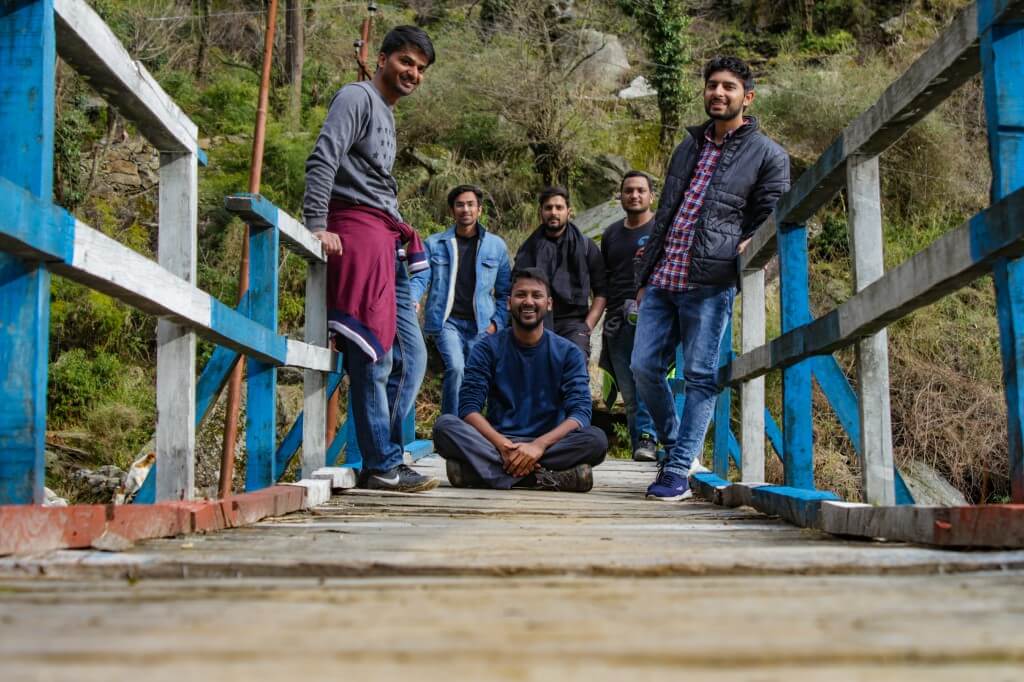
Getting on the wrong trail
We were in a hurry due to the rain and because of that, we went on the wrong trail. We did not know that the route was going to Gushaini or somewhere else but we were sure that we would reach a village at least where we could stay because the water stream was going parallel to the trail. There was no option of returning, so we decided to continue the descent on the same trail.
After continuing for 15 minutes, we found a massive landslide on the trail. Now that was the moment when everyone was looking at each other without saying a single word. In short, we all got scared after seeing the landslide. Since there was no alternate route, we decided to cross that landslide after having a discussion. As I was the experienced one out of all, I volunteered and climbed through that landslide. It was a tough task and a bit risky as well because the mud was wet due to rain which made the climb too slippery.
One by one, all the group members traversed through that landslide and negotiated it successfully without getting injured. We wanted to stop for a while and applaud ourselves for what we did but it started raining heavily. So we began running on the trail to finish the trek as soon as possible. We reached a village in the next 15 minutes and fortunately that village was Gushaini. Then we came to know that it was the same landslide that we saw while going up in the morning. We couldn’t recognize the same as it was completely dark. We got into our car and searched for a hotel for the night stay.
While having dinner, we recalled that moment and discussed how we crossed that landslide. The moment filled all of us with an adrenaline rush. Though it was quite risky but we did not have any other option. At last, we made a memory. 😀
The Rolla trek from Gushaini is an easy trek and goes through the dense forests of the Great Himalayan National Park. The distance is around 7 km and the terrain is very less steep except some stretches. The trail remains lesser crowded and full of lush greenery. Beginners can go for this trek.
Check out the next part
Exploring Shangarh in Sainj Valley – A Beautiful Hamlet having Meadows & Temples
Happy Trails 🙂
Manu Khandelwal
An engineer and a travel blogger. Loves trekking and doing bike road trips. Burger lover (want to try every burger in the world). Clinomaniac. Sports fanatic. Likes technology but not a technology addict.
Recommended Articles
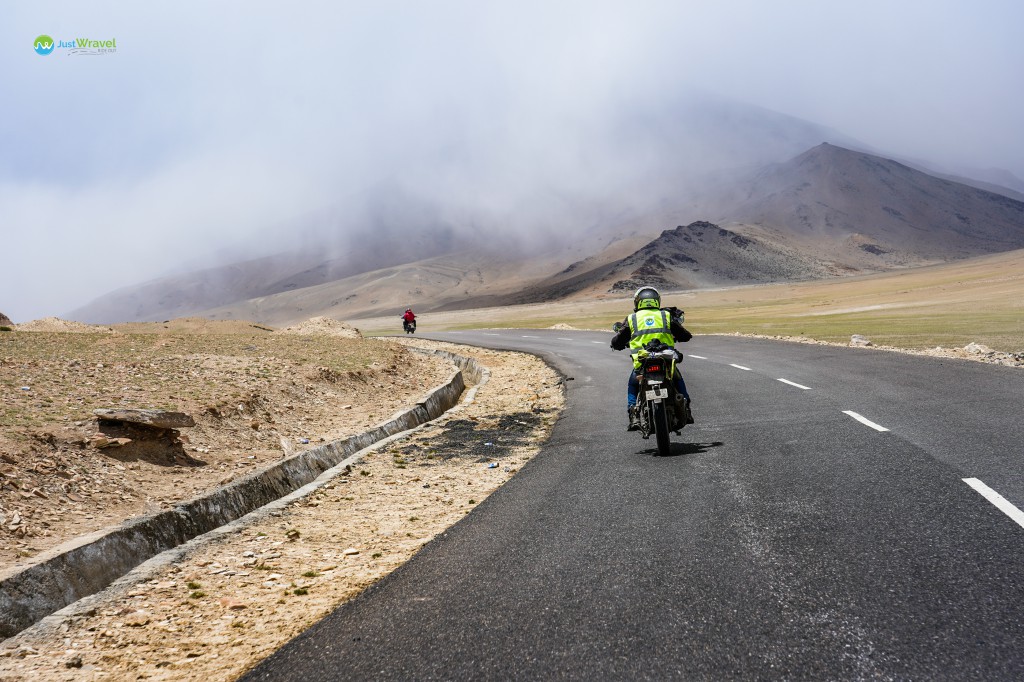
Manali to Leh, Ladakh – one hell of a ride
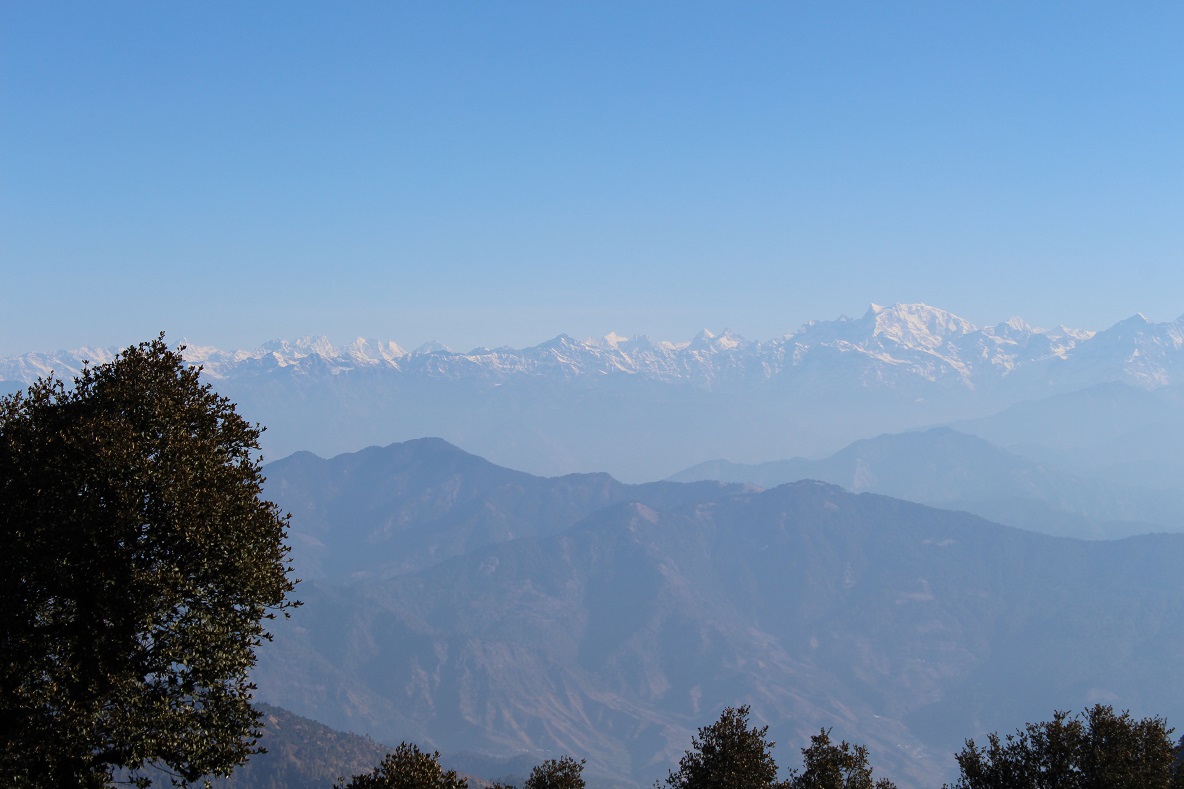
Freedom and Longing in Mukhteshwar
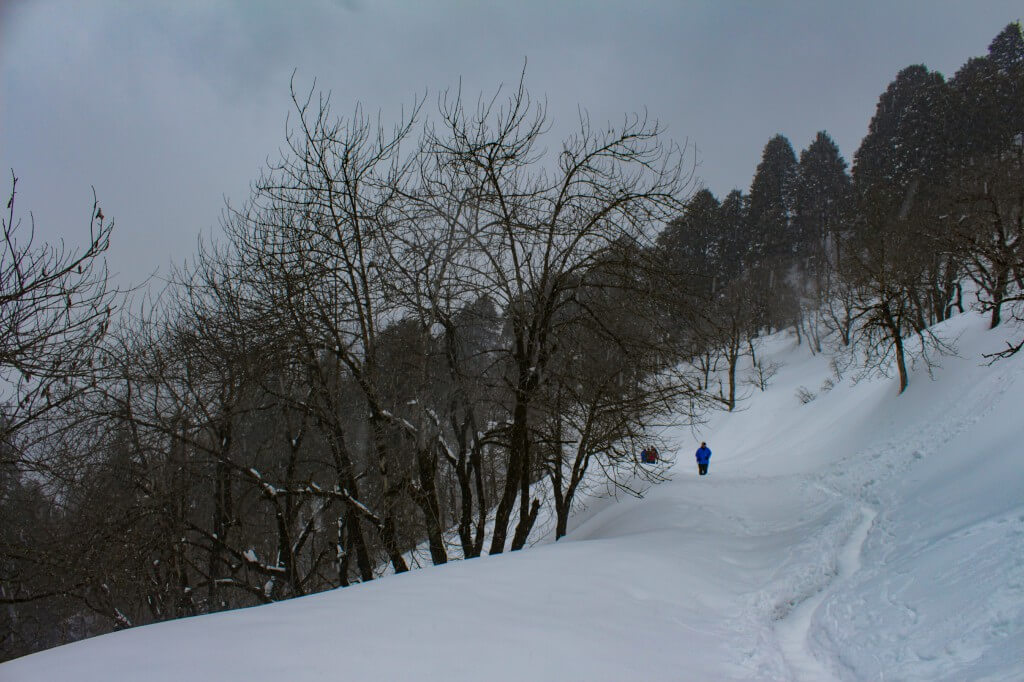
Exploring Jibhi & Jalori Pass – A Trip with Flatmates
i like such a beautiful to know it
great trek for beginners
This place: Added In my bucket list
yeah..you must visit 🙂
[…] Exploring Jibhi & Jalori Pass – A Trip with FlatmatesRolla Trek in Great Himalayan National Park […]
[…] Trek from Gushaini to Rolla – Exploring Great Himalayan National Park– Exploring Shangarh in Sainj […]
Amazing pics and good information..
Leave a Reply Cancel reply
Your email address will not be published. Required fields are marked *
Yes, add me to your mailing list.
- River Rafting
- Rock Climbing
- Scuba Diving
- Wildlife Safari
- View All Tribes
- Ajeet Bajaj
- Amit Chowdhury
- Gayatri Sawhny
- Latika Rana
- Rajesh Kalra
- View All Gurus
activity guide
- Bungy Jumping
- Hot Air Ballooning
- View All Activity Guides
destination guide
- Lahaul and Spiti
- Lakshadweep
- Nubra Valley
- View All Destination Guides

NORTH INDIA
- Himachal Pradesh
- Uttarakhand
SOUTH INDIA
- Western Ghats
INTERNATIONAL
- South Africa
- United Kingdom

LAND ACTIVITIES
- Camel Safari
- Horse Safari
- Jeep Safari
- Mountaineering
- Motorsports
- Photography
AIR ACTIVITIES
- Bungee Jumping
- Paragliding
WATER ACTIVITIES
- River Cruising
- Family Outings
- Fixed Departures
- Weekend Getaways

` 9,500 per person
Duration: 3 days, talk to an expert, 0124-6907340.
Bounded by Himalayas from all the sides, the Great Himalayan National Park in Himachal Pradesh offers lush meadows, snow clad peaks, the enchanting Tirthan River and Himalayan flora and fauna. It has distinct, endangered and regionally endemic Himalayan species - Himalayan Musk Deer and Snow Leopard being the prominent ones. Seek adventure on the Great Himalayan National Park Trek and spend days amidst the Himalayas by the Tirthan River. Trekking here is the best way to explore around as the National Park has beautiful parts of the Tirthan, Sainaj, Jiwanal and Parvati Valley named after the rivers that originate in the Park. The Oak forests, blooming rhododendron trees, sparkling rivers, unexplored peaks, and the sight of rare animals and birds will make your experience amazing!
Our trek starts from Gushaini from where we walk towards Rola along the Tirthan River to reach the gate of the national park and finally reach Shilt. We will witness a distinct culture as soon as we enter the villages of the park. The place is so isolated and away from the hustle bustle of the towns and cities that locals have developed their own traditions and culture. It will be fascinating to experience that! GHNP has limited options for accommodation, so homestays and camping are the best options to stay and admire the beauty of the place.
When we visit these kind of remote places, we have to understand that the locals and the communities who live here have limited resources due to harsh climatic conditions and accessibility issues. So we will make sure that we travel responsibly, create awareness about eco- tourism and contribute to the development of the society.
Know more about other popular options for Trekking in Himachal Pradesh
Day 01: Aut - Gushaini Arrive at Aut in Himachal Pradesh on your own; direct buses are easily available to Aut from Delhi or Chandigarh. We will drive to Gushaini in Tirthan valley, where we start out trek for the day. Trek to Rola is short and pleasant; the trek begins at the roadhead of Gushaini. We trek along the Tirthan River and after crossing Ropa and Kauncha, we will reach the park gate. It is one of the best treks for beginners where one can admire the distinct flora and fauna of the Great Himalayan National Park. Reach Rola by evening and spend the night there.
Day 02:Rola - Shilt (10498 feet | 8 KMS | 4 hours) We will continue trekking along the Tirthan River and soon start following a narrow trail which climbs steeply across the forest. Today is the best day to explore the park, do bird watching, and click pictures to take home some good memories! We reach Shilt Hut in 3 hours, spend the day sightseeing, and take in the beauty of the majestic glaciers around. We will return to Rola after lunch and spend the night in tents.
Day 03: Rola - Gushaini - Aut (9842 feet | 9 KMS | 4 hours)
We will trek back to Gushaini early morning from Rola. We will drive you to Aut and drop you off to continue your onwards journey.
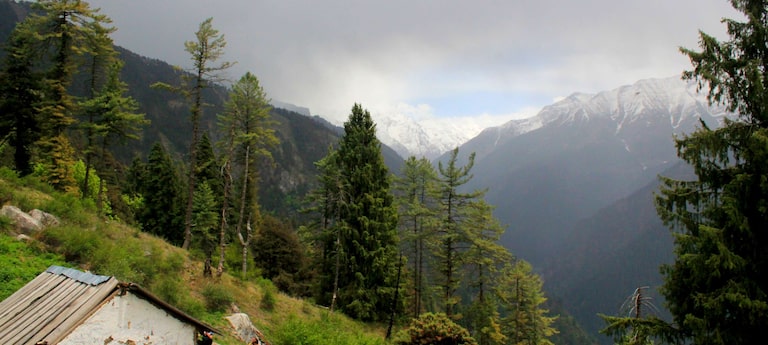
Package Details
Great himalayan national park trek, price (per person): ` 9,500, duration: 3 days, cancellation policy | payment policy.
Departure : April 2017 - 14th April
Maximum Altitude: 10498 feet Grade: Easy to Moderate Best time to go: April to November
Note : We require a minimum of 8 passengers to operate the trek on fixed departure price. For 2 - 4 pax it will cost 12500 per person.
Inclusions:
Exclusions:.
- Transport support throughout the trek
- Experienced mountain guide & cook
- Camping arrangement (tents + sleeping bag + camping mattresses + camping stool/chair + mess tents + first aid)
- Forest entry charges payable at forest check post
- Porter/mule for carrying camping equipment & ration
- Any meals while travelling
- Guesthouse accommodation anywhere apart from mentioned above
- Any tips, laundry, phone calls, medicines, personal expenses on any other meal or drinks
- Personal porter support will be chargeable at Rs.300 per bag per day. Weight of 1 bag should not increase 12 kg
- Anything not mentioned under inclusions
Reviews for Great Himalayan National Park Trek
Be the first to share your experience with us. Send your feedback at [email protected]
Similar Adventures
Cancellation policy.
CANCELLATION POLICY
Cancellation charges per person
30 days or more before departure: 25% of total cost 29 - 20 days before departure: 50% of total cost Less than 20 days before departure: 100% of total cost
IF WE CHANGE OR CANCEL YOUR ADVENTURE HOLIDAY
We do plan the arrangements in advance. It is unlikely that we will have to make any changes to your travel arrangements. Occasionally, we may have to make changes due to Force Majeure Events and we reserve the right to do so at any time before or during the trip. If there are any changes, we will advise you of them at the earliest possible date before or during the trip based on the Force Majeure Events. We also reserve the right under Force Majeure Events to cancel your travel arrangements / offer alternative dates / revise the itinerary before or during the trip. Any additional cost incurred due to the above-mentioned reasons will have to be borne by the traveller himself. There shall be no refund to the traveller under Force Majeure Events.
Force Majeure Event shall mean and include any circumstance beyond the reasonable control of Adventure Nation, including without limitation, any act of nature or the public enemy, accident, explosion, fire, storm, earthquake, flood, drought, perils of the sea, casualty, strikes, lock-outs, labour troubles, riots, sabotage, terrorists acts, embargo, war (whether or not declared), governmental actions, delay in issuance or processing of Visa/permit, change of laws and regulations, orders, or decrees, or other causes of like or different character beyond the control of Adventure Nation.
IF YOU WANT TO CHANGE YOUR ADVENTURE HOLIDAY PLAN
After you make full or partial payment, if you wish to change your travel arrangements in any way (e.g. your chosen departure date or accommodation), we will do our utmost to make these changes but it may not always be possible. Any request for changes must be in writing from the person who made the booking. All cost incurred due to amendment will be borne by the traveller himself.
Payment Policy
46 Days or more before date of departure: 25% of total cost. 31 - 45 Days before date of departure: 50% of total cost. 30 days before date of departure: 100% of total cost.
Important: The booking stands liable to be cancelled if 100% payment is not received less than 30 days before date of departure.
- Submit Query
Provide your details, we'll call back
EMI Options
*Including GST
Sign in to your adventurenation account, login to your account, invalid email address or password, sign up and get the best adventure deals, sign up & get best deals.
- Accessible Adventures
- Adventure Running
- Off Roading
- Outdoor Photography
- Wind Surfing
Invite your friends.
Sent you a adventure nation request.
You have been invited to join adventurenation.com, a community for outdoors enthusiasts where you can join Tribes, interact with Gurus and get up to speed on adventure activities and destinations
Suggested Friends
You are using an outdated browser. Please upgrade your browser .
- Raghupur Fort Trek
- Tour guides
View on map
Description
Raghupur fort is located near Jibhi, Kullu and is one of the most scenic treks with just 3 km of the hike. This trek has the most complete view of the Great Himalayan National Park and it stretches to Jibhi and Shoja valley Shoja. Also known as Ragupur Garh, the Raghupur fort is a 4km stretch that passes through beautiful pine and deodar forest with spectacular views of snow-covered mountains. It is a perfect trek for a family with kids or someone who just wants to have a taste of trekking without tiring himself. An ideal way to enjoy this would be to spend one night in camps under the stars with the best view of milky-way. This place is also home to various bird species and wild animals. Things get better when you have the best guide in the valley walking along with you and every trek is incomplete until you are aware of the history of a place. So we have specially designed this trek for families and couples for two days where they can have a feel of the trek and have enough time to surrender themselves to mother nature.
Duration: 1 Night / 2 Days
Difficulty: easy.
Highlights :
- Full of twist and twirls, this trek will take you through the mindboggling landscapes
- Enjoy the stunning view of Pir Panjal Ranges
- Tourist guide
Write your review
- Long Weekend Trips
- All Girls Trips
- Domestic Tours
- International Tours
- Upcoming Trips
- Corporate Program

Welcome Guest
- Backpacking
- Budget Trips & Treks
- Himachal Pradesh
- National Park & Wildlife
- Weekend Getaways
Road trip to Jibhi, The Great Himalayan National Park. A photo blog
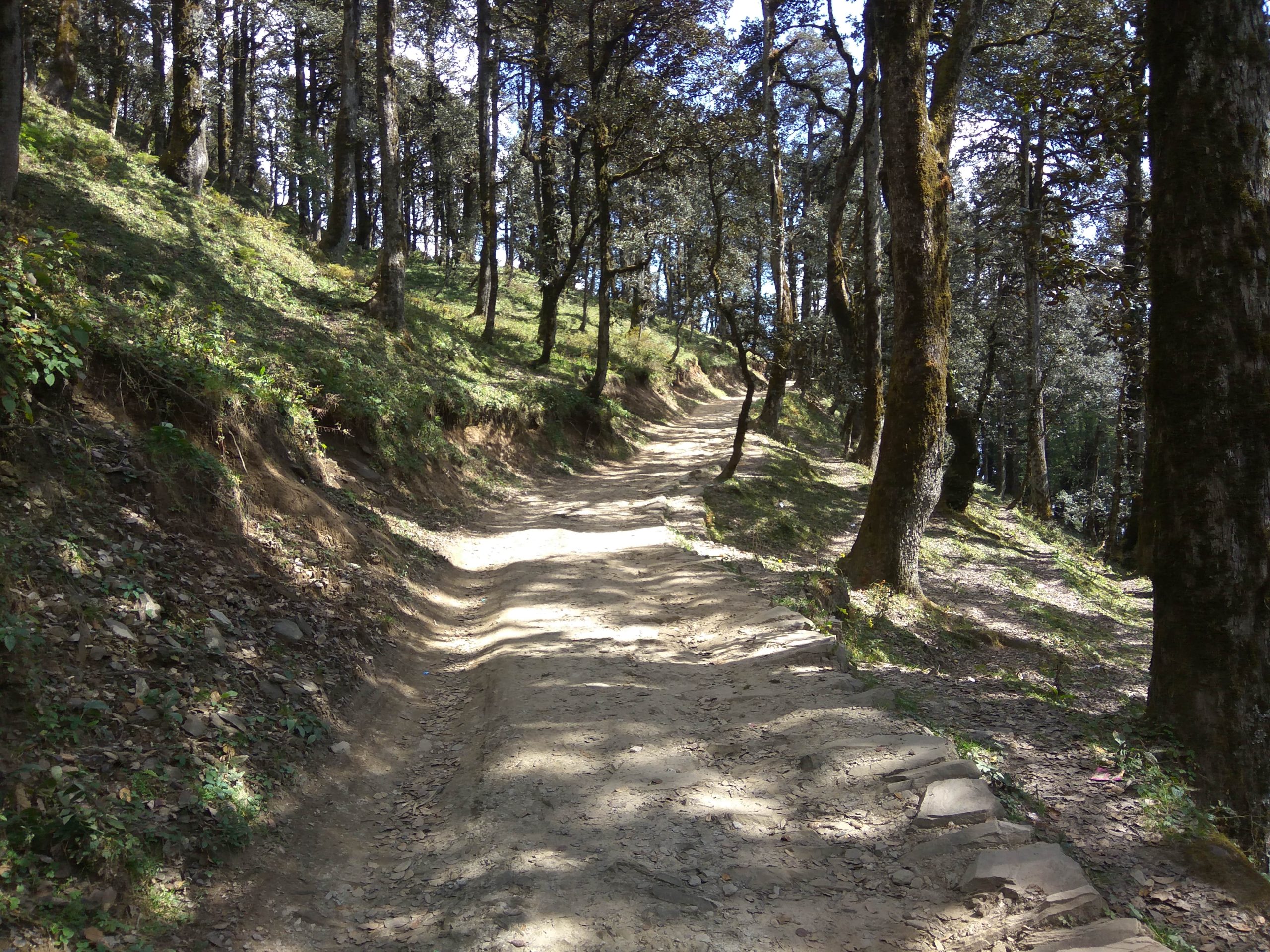
Written by Just Wravel 21 Oct, 2016
Jibhi is a secluded gem in the Tirthan/ Banjar Valley of the Great Himalayan National Park, about 40 kms from Aut.
A serene picturesque location in Himachal Pradesh which usually goes unnoticed because of the newly constructed tunnel which guides people to Kullu and Manali. Making Jibhi a perfect weekend or extended weekend getaway for Wravelers looking to stay away from hustle bustle of overcrowded tourist destinations.
The mountains surrounding Jibhi are lush with pine and cedar forests and it is also just one hour away from the highway connecting Manali and Chandigarh. A short drive from picturesque Jalori Pass, Jibhi is a good base for hiking, birding, relaxing, and enjoying the outdoors
Wake up in the mountains. Jibhi is 496 kms from New Delhi. Reaching Jibhi from New Delhi takes around 14 hrs. There are several homestays and hotels in Jibhi.
After lunch, we spend some leisure time by the river side.
Evenings will be cold, bonfire is arranged by the hotel staff which makes it even more memorable, so get back to the hotel by Sunset.
Bonfire with veg snacks in the evening.
View from Hotel room.
After breakfast, we move towards Jalori pass which is at an altitude of 3120 mts.
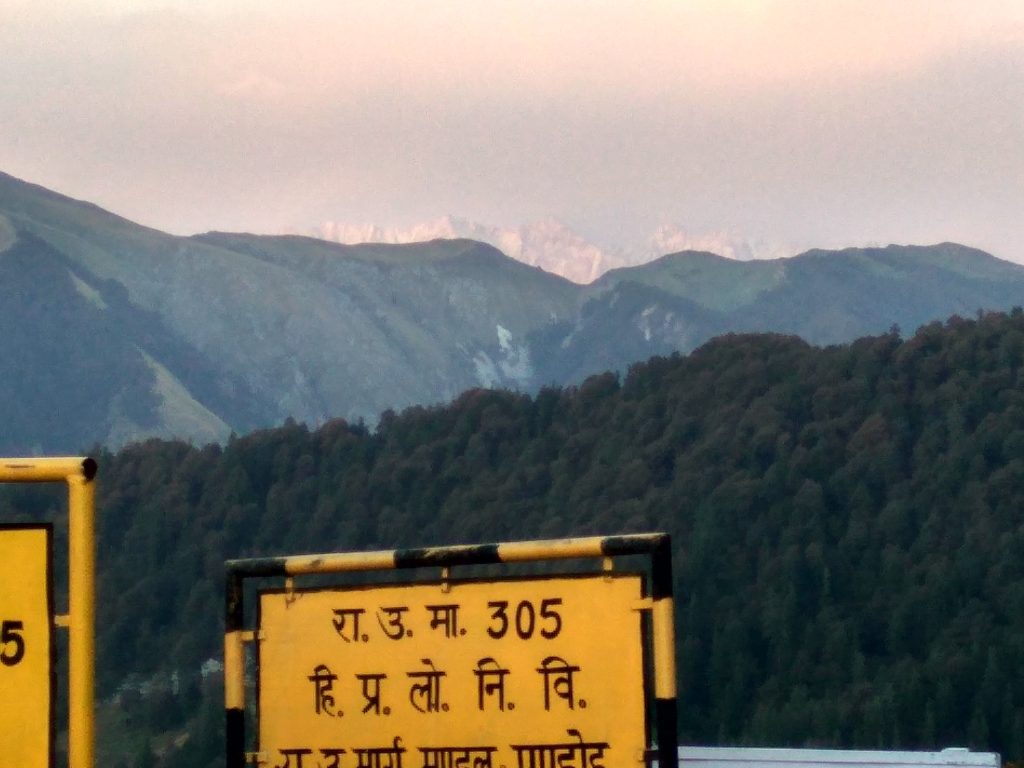
Trekking in The Great Himalayan National park is a must activity. Leisure walks is also recommended.
Trek to Sirolsar Lake which starts from Jalori Pass through a thickly narrow path. One can get an occasional view of meadows beyond the thick curtain of the forests. It is a moderate trek which will be covered in snow during that time.
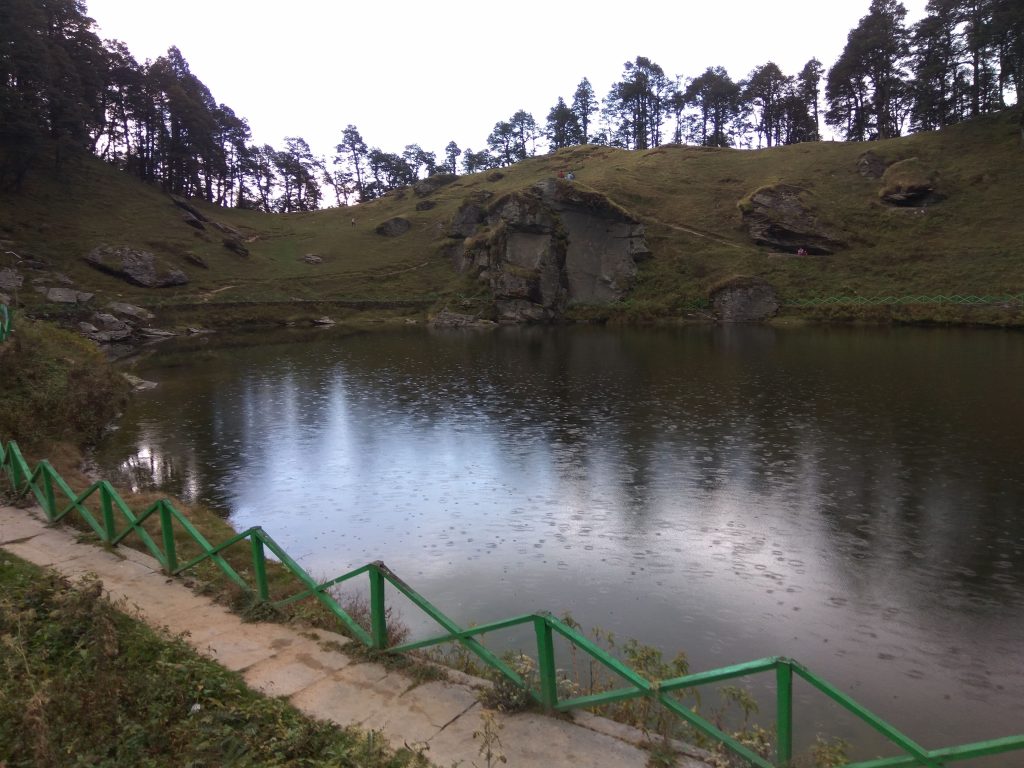
Day trip and hike to Chaini Fort and Sharingi Bagi Temple.
Sharingi Rishi temple, built in Pagoda cum Pahari style is having four roofs and elaborate woodwork.
For travel related queries,outstation cab booking,bike rentals, Hotel bookings or Group Tours ; Kindly contact us at https://justwravel.com/contact or call +91- 9205725727
Web Stories
Leave a comment, subscribe newsletter.
Just Wravel
Latest Blogs

B-42, 2nd Floor, Tower- B, The Corenthum, Block A, Sector 62, Noida, Uttar Pradesh 201301
+91-8810 457 631
© 2015-2024 JustWravel Pvt. Ltd.

B-42, 2nd Floor, Tower- B, The Corenthum, Block A, Industrial Area, Sector 62, Noida, Uttar Pradesh 201301
Group Tours
Customized Trips

Sainj – Tirthan Valley Trek
- Tirthan valley – Morahani Trek
- Tirthan valley – Tirath Trek
- Shreekhand Mahadav Trek
- Sainj valley – Raktisar Trek
- Tirthan valley – Gushaini to Rakhundi Trek
Note: A reverse route of the above trek is also popular. Distance from Neuli to Gushaini: about 85 kms.
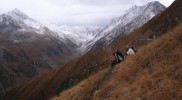
WEBSITE RELATED LINKS
- Accessibility Statement
- Downloads and Plug-ins
- Website Policies
- Terms & Conditions
GHNP RELATED LINKS
- Park Organisation
- News & Articles
- Media & Press
- GHNP’s Blog
EXTERNAL LINKS
- India’s Portal
- Himachal Pradesh’s Portal
- District Kullu’s Portal
- Himachal tourism’s Portal
- HP Government Holidays
- Emergency Contacts
CONSERVATION
- Conservation Overview
- Known Pressures in GHNP
- Present Day Scenario
- Institutional Framework
- Management Plan
- Protection Measures
- Research and Monitoring
- Conservation Education

Content on this website is published and managed by Great Himalayan National Park Authorities. For any query regarding this website, please contact the Web Information Manager.
HIT COUNTER 3424150
LAST UPDATED 19 June, 2024

IMAGES
VIDEO
COMMENTS
Shilt Hut Trek: A 7kms hike from Rolla enroute Chhordwari waterfall and bamboo forest will take you to the Shilt Hut(3100 m) which is the next camping site after Rolla and renders a nice view of the Park. Total distance from Gushaini to Shilt Hut is 30Kms enroute Rolla. Its a 3 days trek with 1st night at Rolla camp and the 2nd night at Shilt Hut.
Trek name Tirthan valley - Morahani trek Trek duration 5 days Trek difficultly Moderate to strenuous Trek description From the starting point, one can see the local ... Trek duration 9 days Trek difficultly Strenuous Trek description Shreekhand Mahadev is a holy place of Lord Shiva Total distance. ... Great Himalayan National Park Shamshi ...
Trek Distance. 26 KM. Group Size. 11. Best Time. April to June. Soak in the shimmering sunrays filtering through the thick canopy of a forest. Sounds magical, doesn't it? A trek to the Great Himalayan National Park offers many such special experiences.
Trekking in the Great Himalayan National Park is a must for nature lovers and trekkers. GHNP is a biodiversity hotspot and a World Heritage Site. Because it is a protected area, there are no roads or facilities within the Park. The only way to explore the pristine wilderness is by foot. Trekkers are allowed to trek in GHNP with recognised and ...
A eight-day trek crossing two valleys. Moderate to strenuous. Experience the transitions between two magnificent valleys. Day 1: Neuli (1500 m) to Shakti (2100 m). . Night at Park accommodation. Moderate ascent. Distance: 22 km. Day 2: Shakti to Dhel (3737 m) . Heavy-moderate ascent through dense forest, walnut trees, medicinal herbs, etc. .
Great Himalayan National Park. Great Himalayan National Park was constituted in 1984 and was formally notified as a national park in 1999. It is located in Banjaar Sub-Division of Kullu District of Himachal Pradesh, India, in the far Western Himalayas. ... Trekking in Jiwa Nal Valley begins at Siund, around 35kms from Aut. Jiwa Nal - Parvati ...
The Great Himalayan National Park (GHNP) is a national park in India, located in Banjar sub-division of Kullu in the state of Himachal Pradesh.The park was established in 1984 and is spread over an area of 1171 km 2; elevations within the park range between 1500 and 6000 m.The Great Himalayan National Park is a habitat to numerous flora and more than 375 fauna species, including approximately ...
According to AllTrails.com, there are 9 camping trails in Great Himalayan National Park (GHNP) and the most popular is Gushaini - Rolla with an average 4.7 star rating from 7 community reviews. Great Himalayan National Park lies in the Kullu district of Himachal Pradesh. It is a widespread park with elevations ranging from 1500 and 6000 m.
The Great Himalayan National Park (GHNP) is one of the most recent additions to a huge network of wildlife reserves found in Himalayan region in India. ... Trek Distance - 7 kms Moderate altitude gain with steep climbs in part. Overall a moderately challenging day. Day 4 - Trek from Shilt hut to Rakhundi (3622 m)
This stunning high altitude trek is a transition between two magnificent valleys: the Sainj and the Tirthan Valley. Located in the state of Himachal Pradesh, the Great Himalayan National Park has been described as "Undoubtedly'', the most pristine mountain landscape in the Western Himalayas." Its unique biodiversity received recognition as a UNESCO World Heritage Site.
Trek name: Tirthan valley - Tirath trek: Trek duration: 7 days: Trek difficultly: ... Distance covered: Description: 01: Gushaini (1500 m) to Rolla (2100 m) 9 Km: ... Content on this website is published and managed by Great Himalayan National Park Authorities. For any query regarding this website, please contact the Web Information Manager.
The Great Himalayan National Park (GHNP) is a World Heritage Site (WHS). The Ecozone is the buffer zone between the Park and the rest of the region. It comprises villages and lands within a 5km radius around the Park. Villages located in the Ecozone are supposed to be closely associated to the protection of the park.
Tags : National Park. Timings : 10:00 AM - 5:30 PM. Time Required : 3-4 hrs. Entry Fee for Great Himalayan National Park : Indian Nationals: INR 50, Foreign Nationals: INR 200, Indian Students: INR 30, Foreign Students: INR 100. Camping Charges : 2 Persons Tent/ per day: INR 100. 3 Persons Tent/ per day: INR 150.
The hike to the GHNP gate is one of the easiest GHNP treks. The trek begins from Gushaini village in Tirthan Valley. To reach Great Himalayan National Park from Delhi, take an overnight bus to Bhuntar and get down at Aut. From Aut, hop on to a local bus to Gushaini. Gushaini to GHNP gate trek starting point is 3 kilometres away.
The Rolla trek from Gushaini is an easy trek and goes through the dense forests of the Great Himalayan National Park. The distance is around 7 km and the terrain is very less steep except some stretches. The trail remains lesser crowded and full of lush greenery. Beginners can go for this trek.
The distance between Gushaini and Rolla is 8 km, and it is considered to be an easy trek. On the first day, the trek will leave you to the gate of the Great Himalayan National Park. The trail from Gushaini to Rolla goes through the jungles of Tirthan Valley. With a basic level of fitness and a will to win the Himalayas, you can trek to Rolla.
THE OFFICIAL WEBSITE OF THE GREAT HIMALAYAN NATIONAL PARK. +91 1902 265320. [email protected]. Accessibility. Screen Reader. AAहिंदी. Home. About. About UNESCO WHS.
0124-6907340. Bounded by Himalayas from all the sides, the Great Himalayan National Park in Himachal Pradesh offers lush meadows, snow clad peaks, the enchanting Tirthan River and Himalayan flora and fauna. It has distinct, endangered and regionally endemic Himalayan species - Himalayan Musk Deer and Snow Leopard being the prominent ones.
THE OFFICIAL WEBSITE OF THE GREAT HIMALAYAN NATIONAL PARK ... Trek name: Tirthan valley - Gushaini—Rakhundi top trek: Trek duration: 5 days: ... Total distance covered: 56 Km (round trip) Itinerary. Day: From / to / Altitude: Distance covered: Description: 01: Gushaini (1500 m) to Rolla (2100 m) 9 Kms;
Raghupur fort is located near Jibhi, Kullu and is one of the most scenic treks with just 3 km of the hike. This trek has the most complete view of the Great Himalayan National Park and it stretches to Jibhi and Shoja valley Shoja. Also known as Ragupur Garh, the Raghupur fort is a 4km stretch that passes through beautiful pine and deodar forest ...
Trekking in The Great Himalayan National park is a must activity. Leisure walks is also recommended. Trek to Sirolsar Lake which starts from Jalori Pass through a thickly narrow path. One can get an occasional view of meadows beyond the thick curtain of the forests. It is a moderate trek which will be covered in snow during that time.
THE OFFICIAL WEBSITE OF THE GREAT HIMALAYAN NATIONAL PARK ... Trek name: Sainj valley - Neuli to Homkhani trek: Trek duration: 5 days: Trek difficultly: ... Total Distance: 56 km (round trip). Itinerary. Day # From / to / Altitude: Distance covered: Description: 01: Neuli (1500 m altitude) to Shakti (2100 m altitude). 22Km:
Distance covered: Description: 00: Arrival at GHNP Complex Sainj Ropa. Night Stay at FRH Ropa. 01: Sainj Ropa(1500 m) to Niharni; Niharni to Shakti base camp(2100 m) 6km by jeep; 15km by walk; Shakti is a village near the entrance of Great Himalayan National Park, There is also a temple of God Bramha,locally known as Shakti Beath: 02